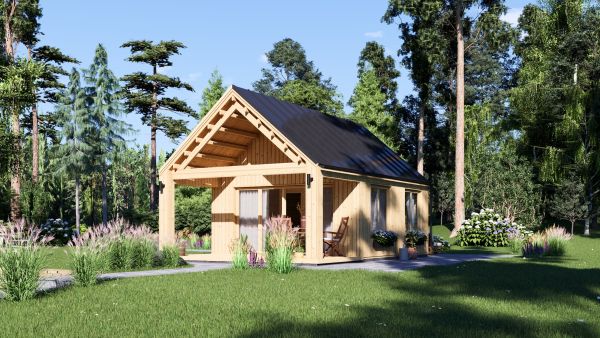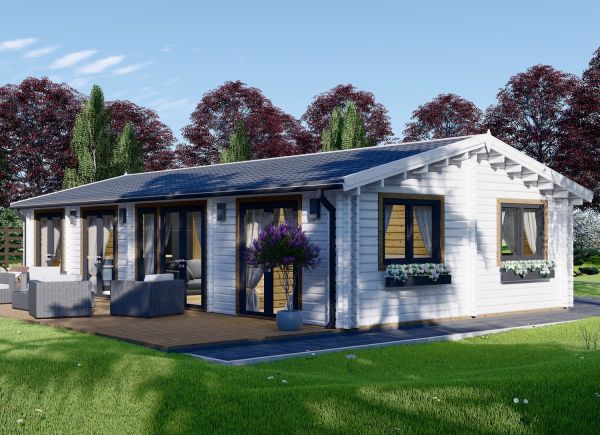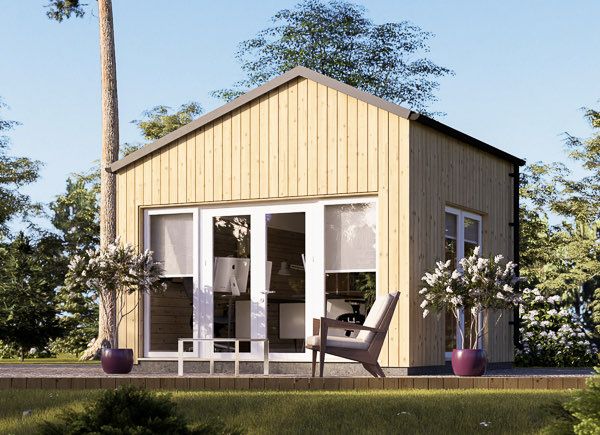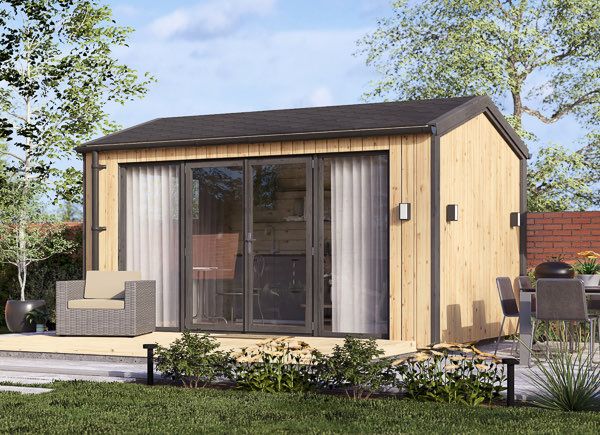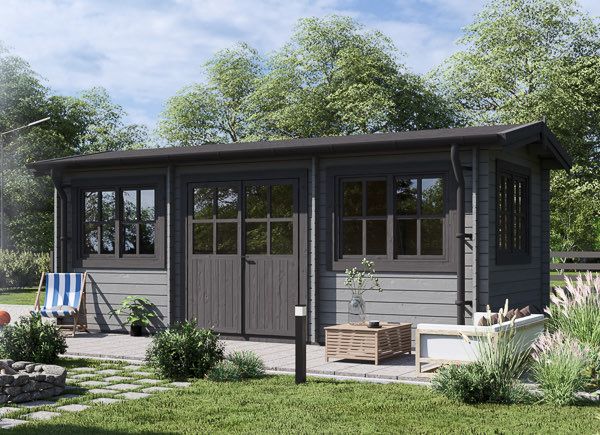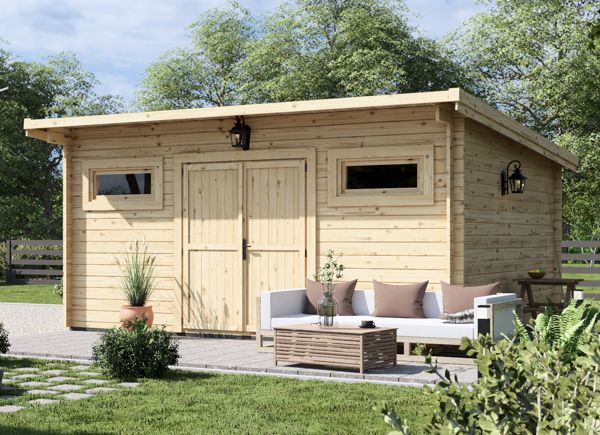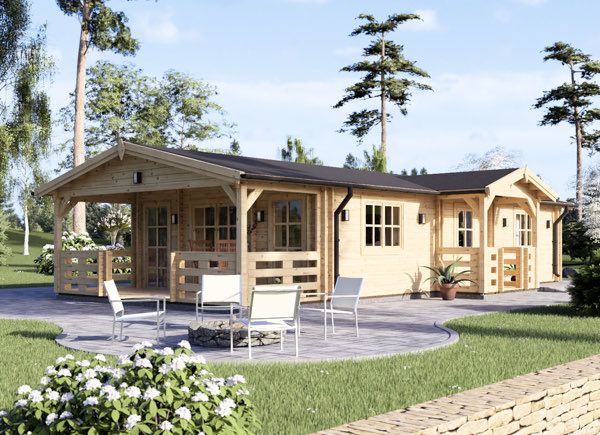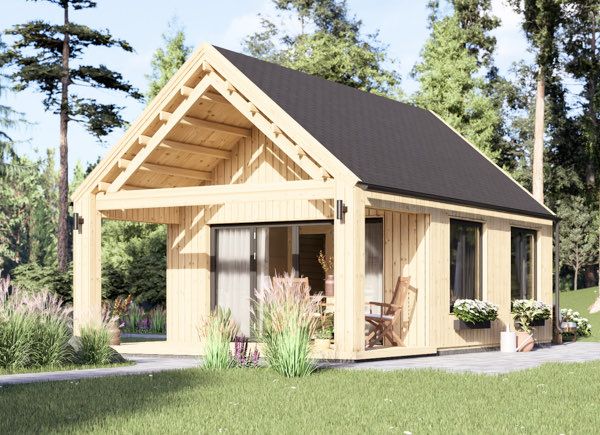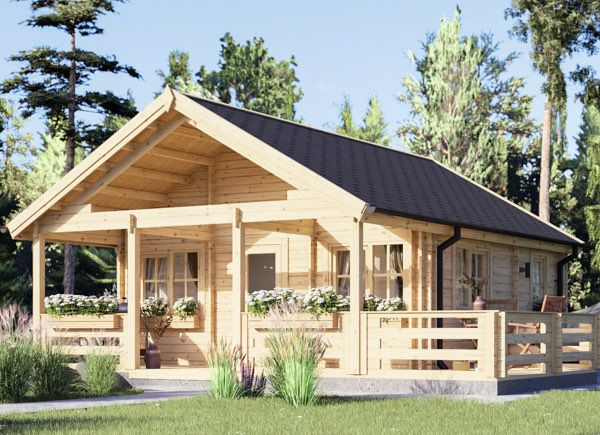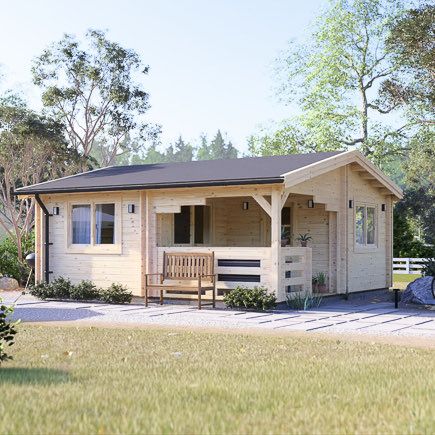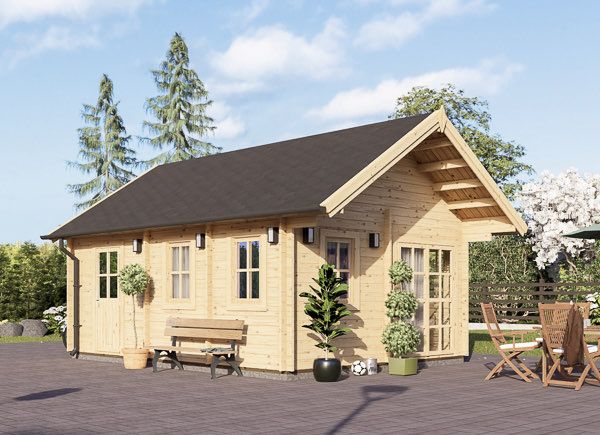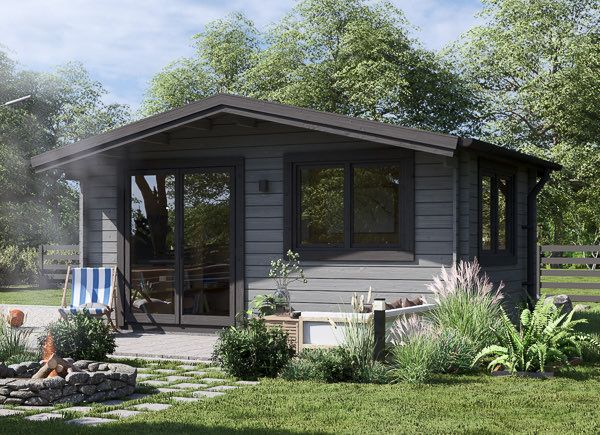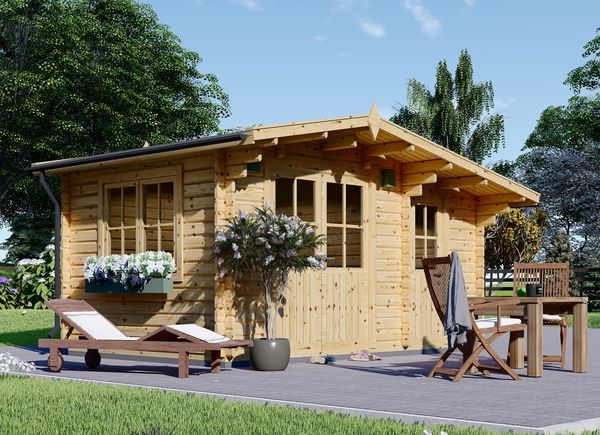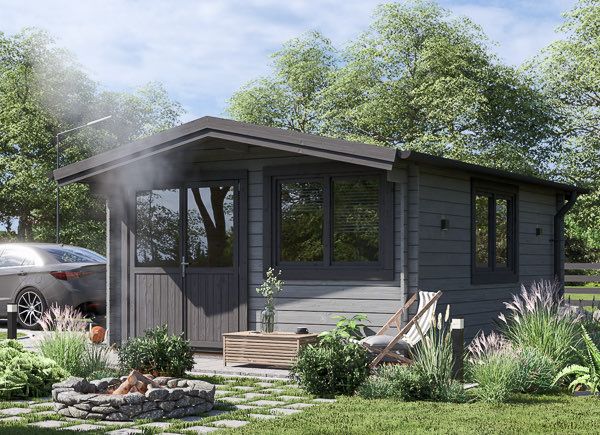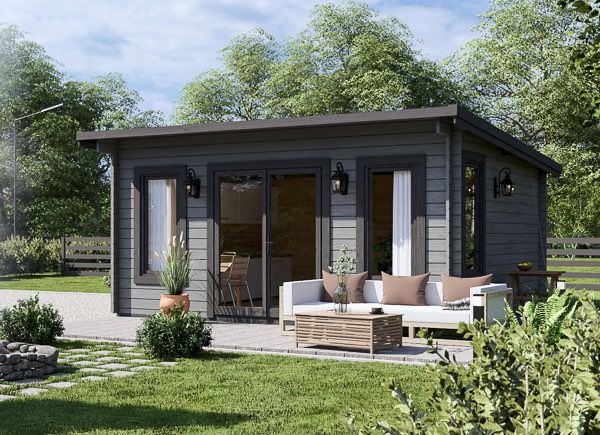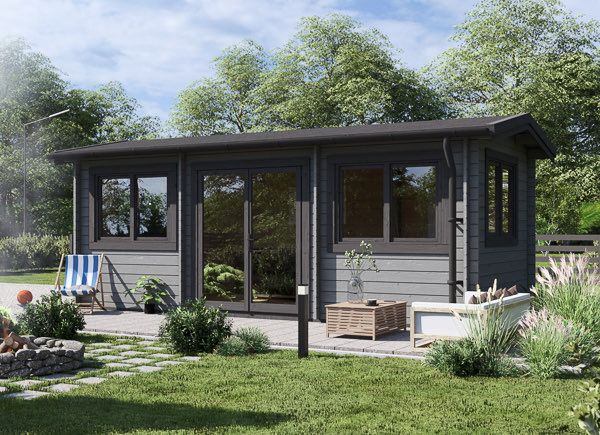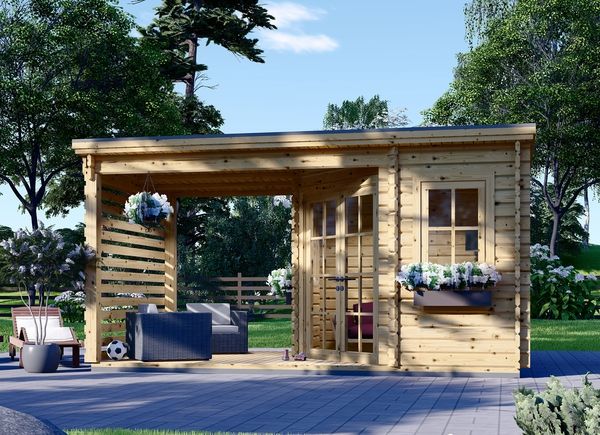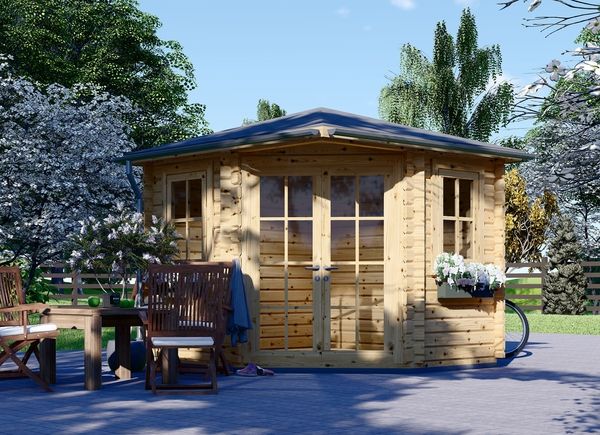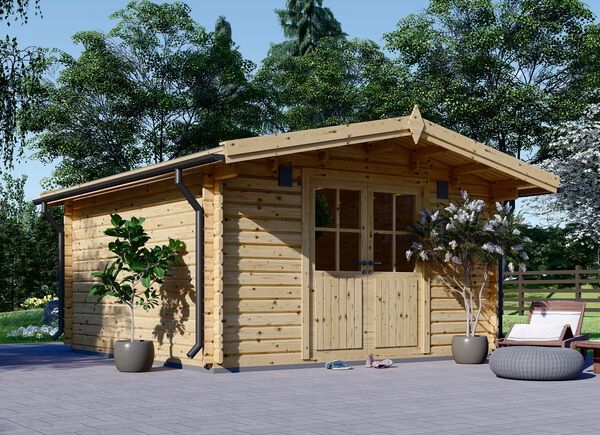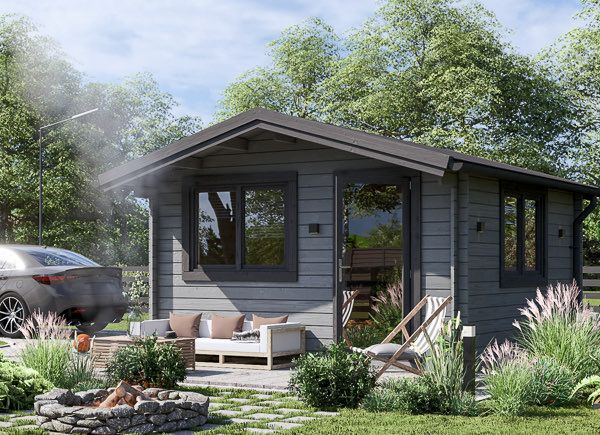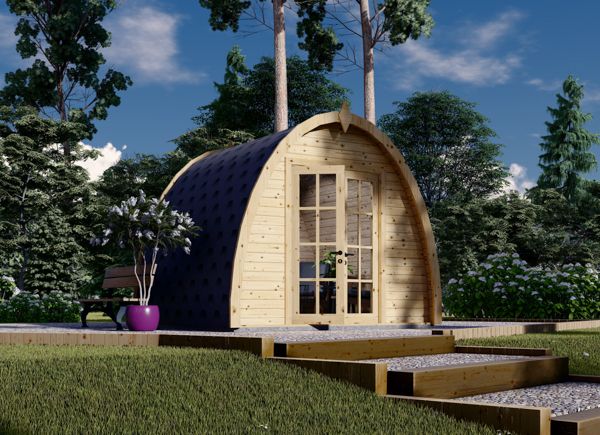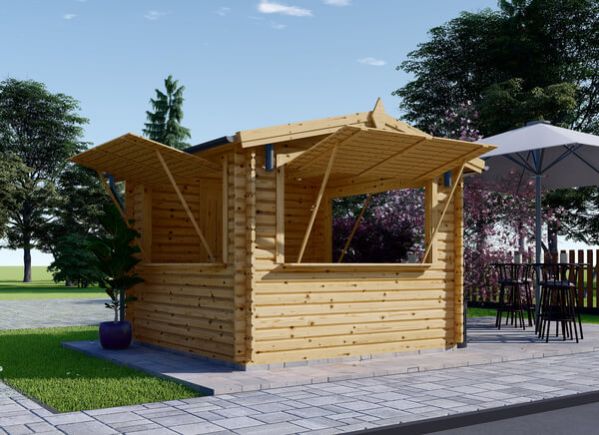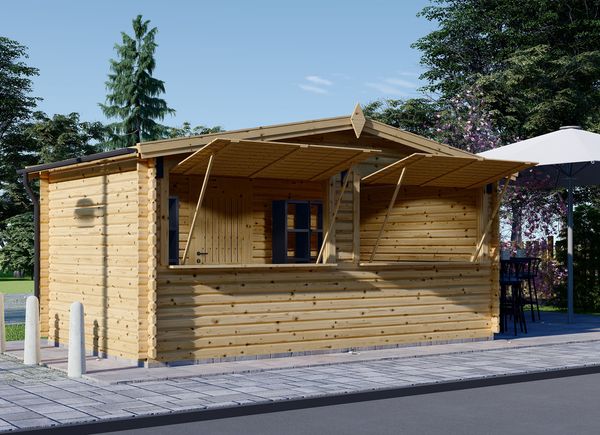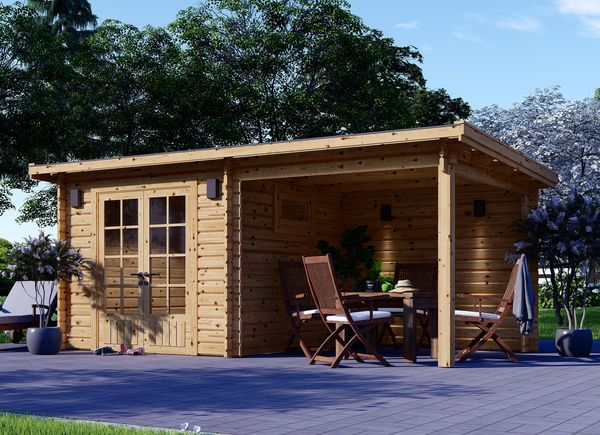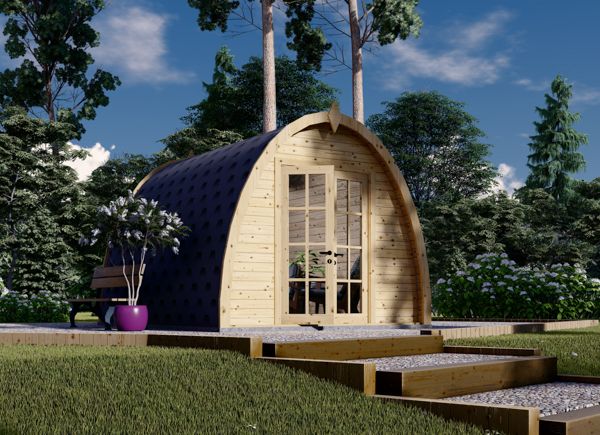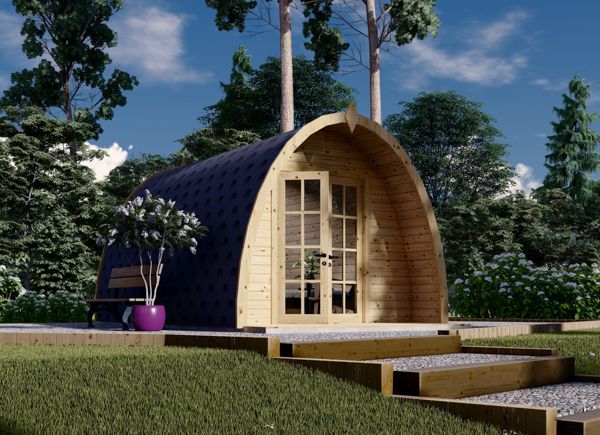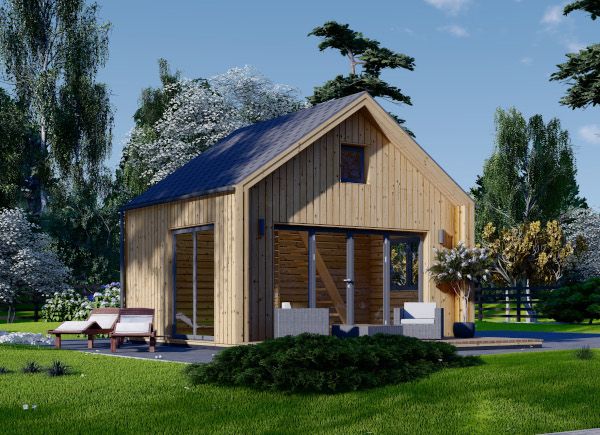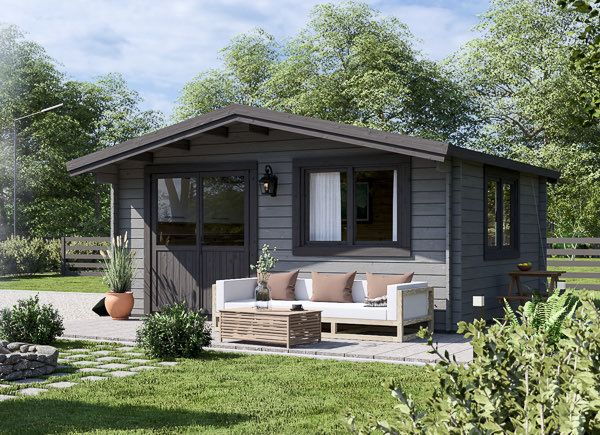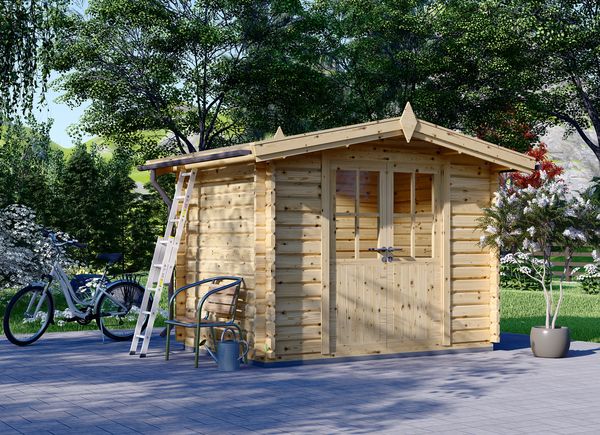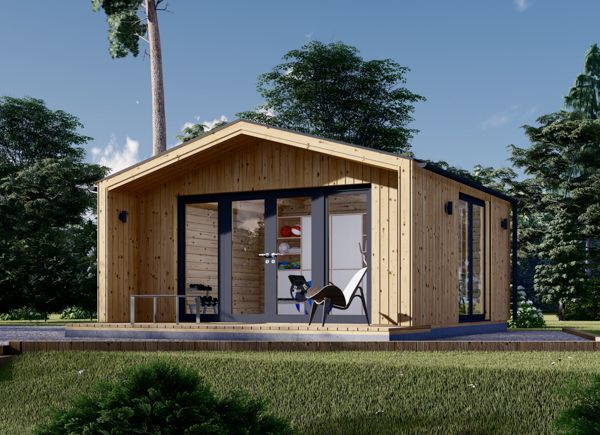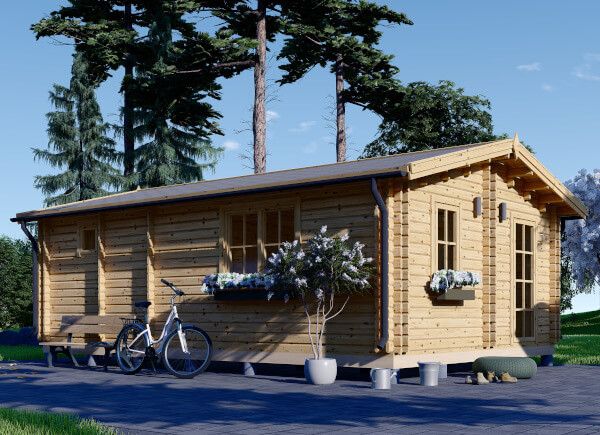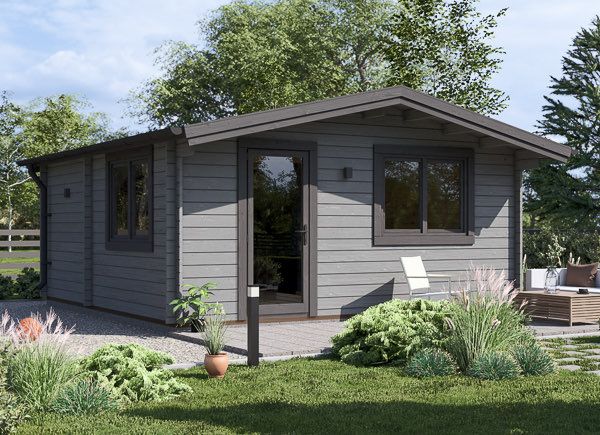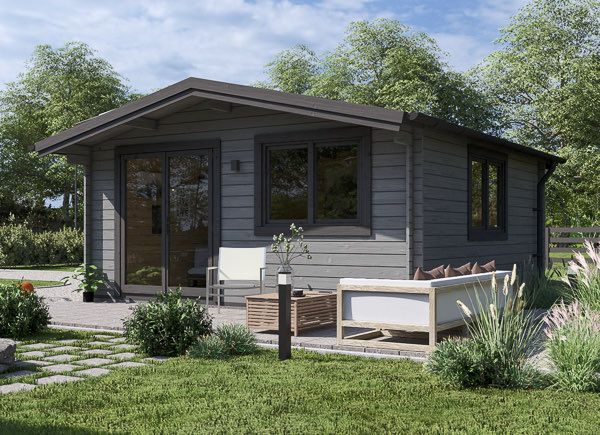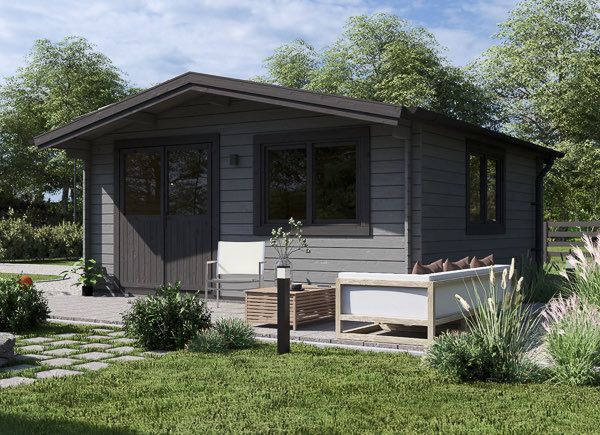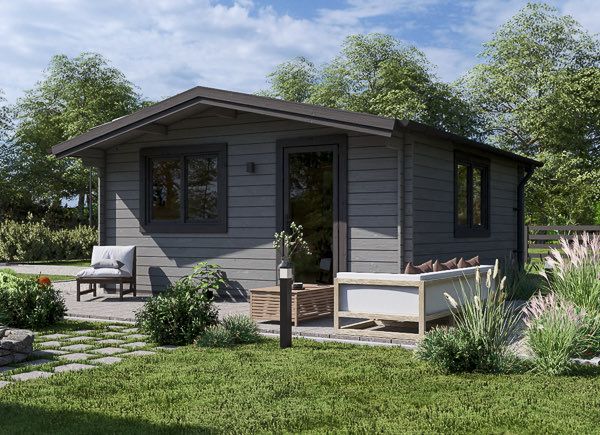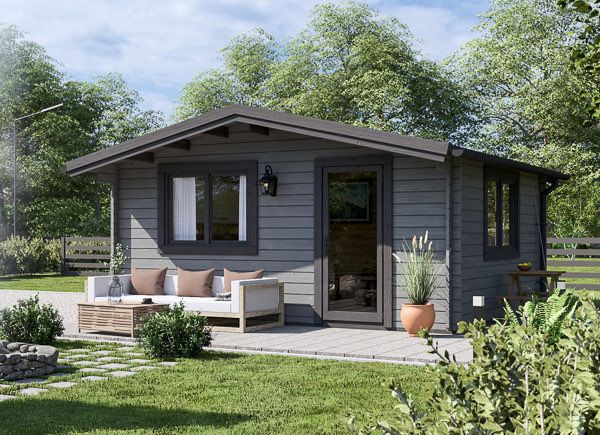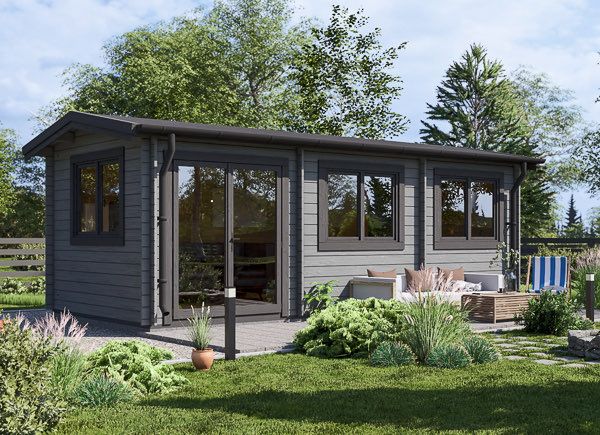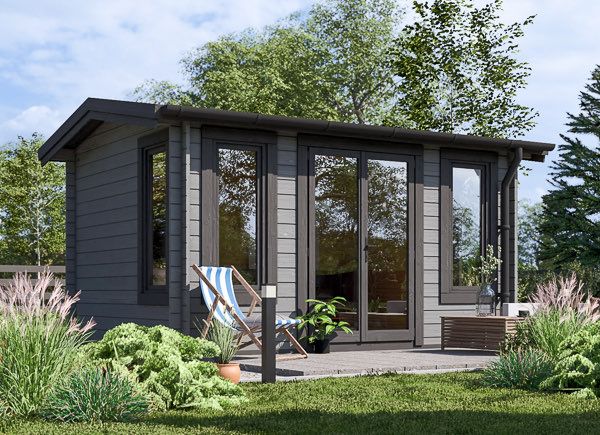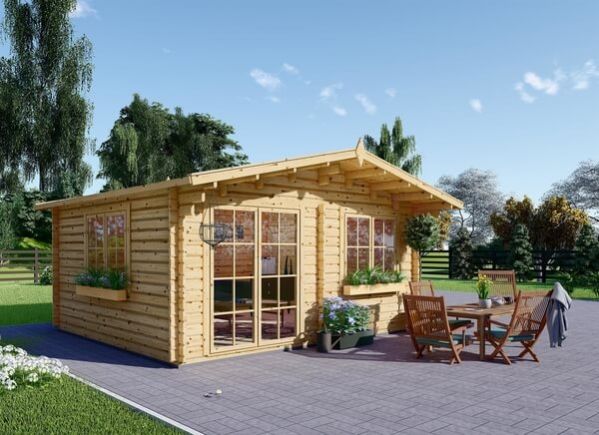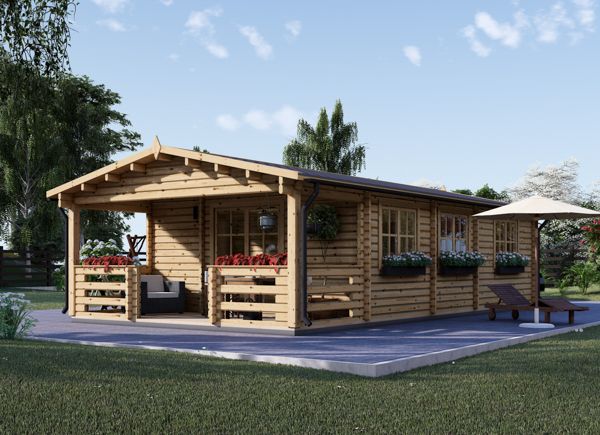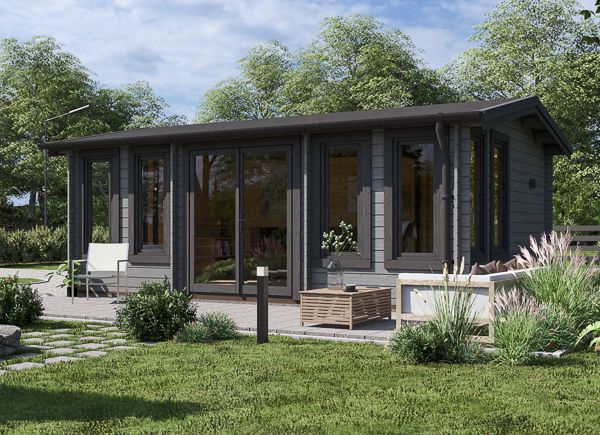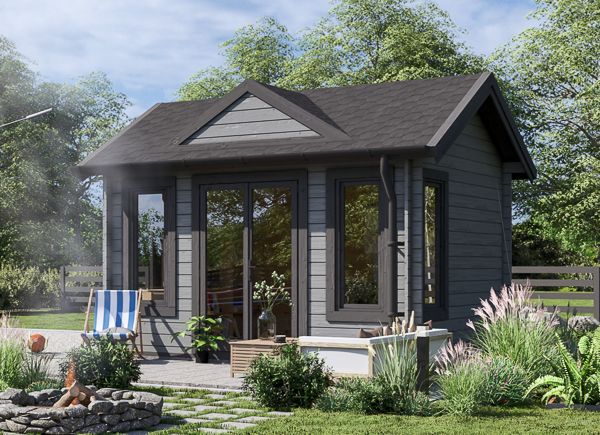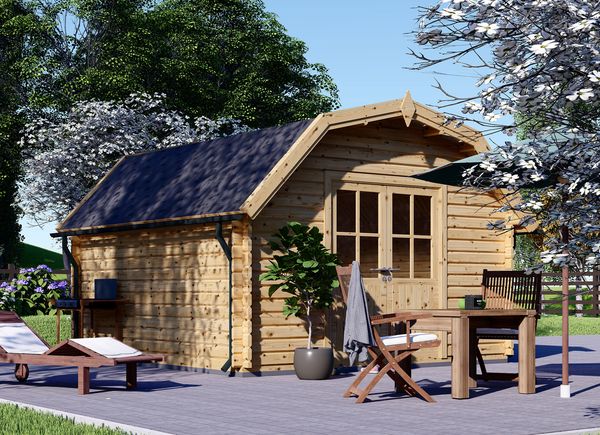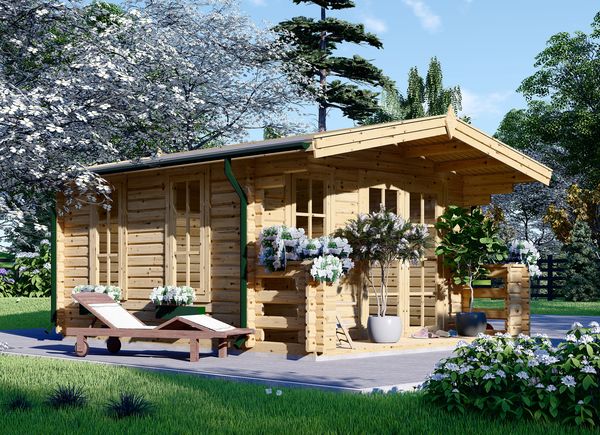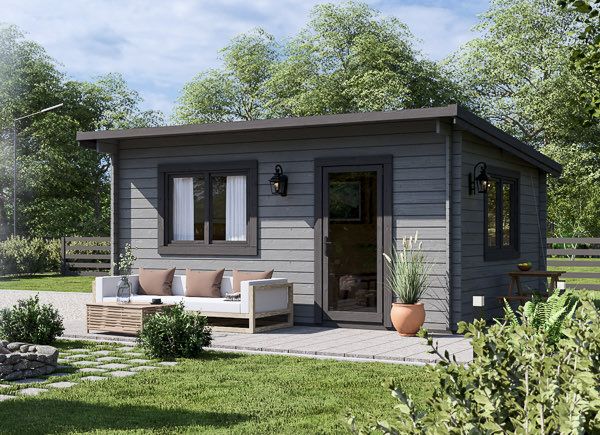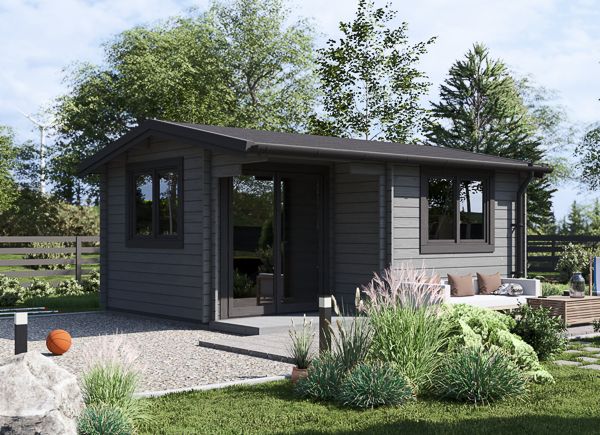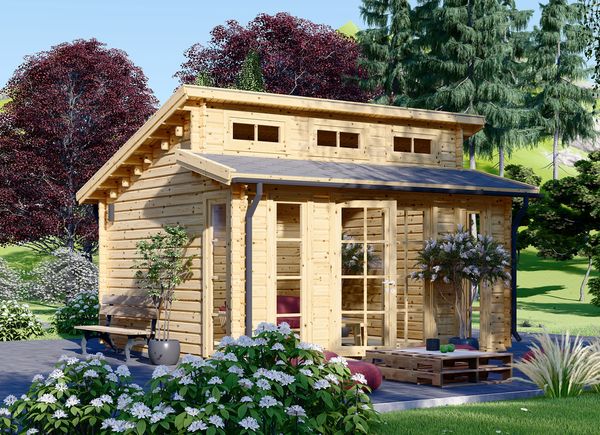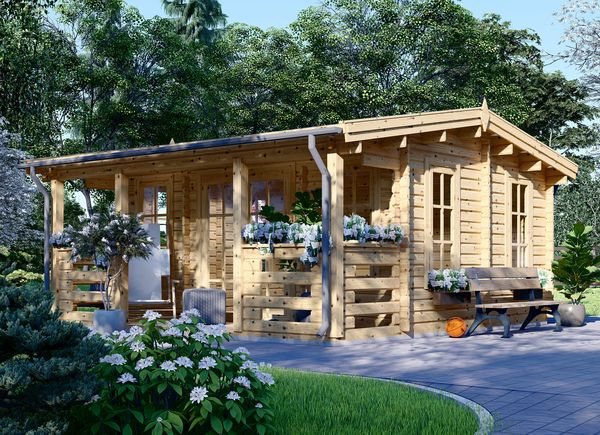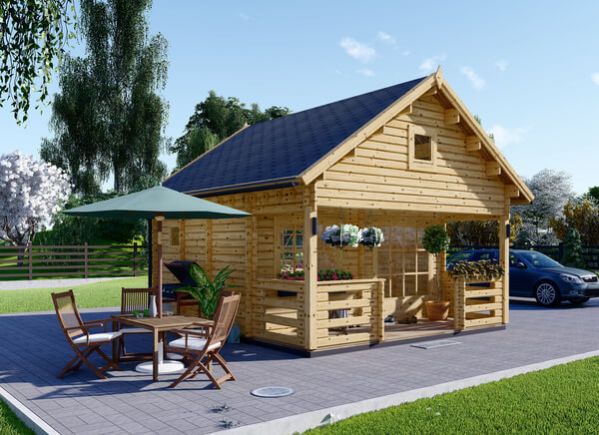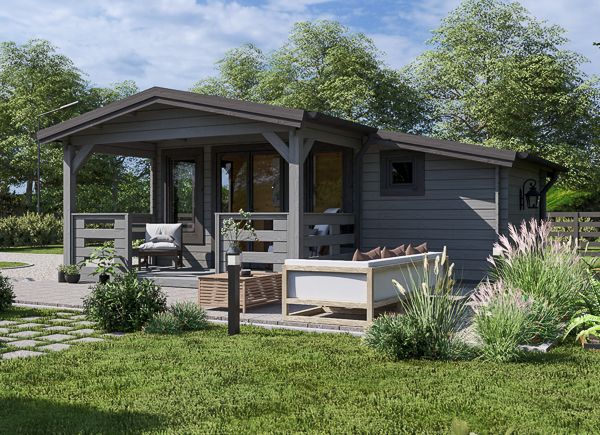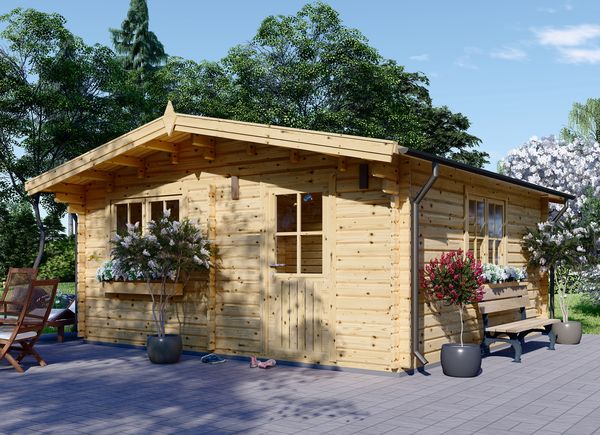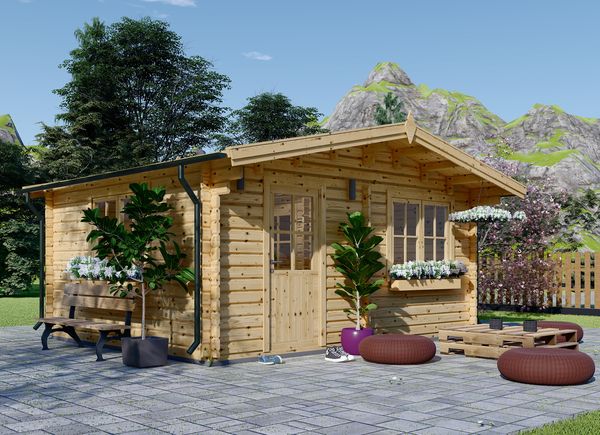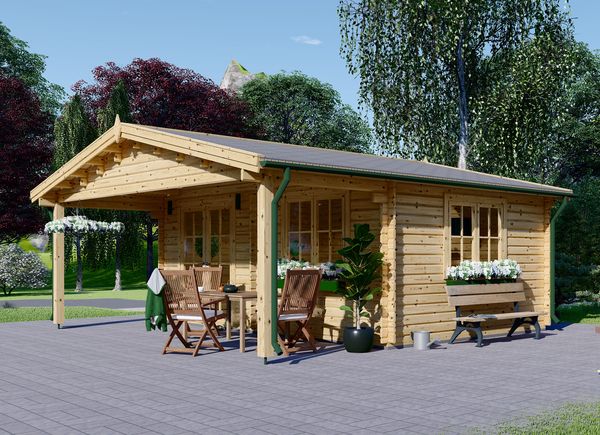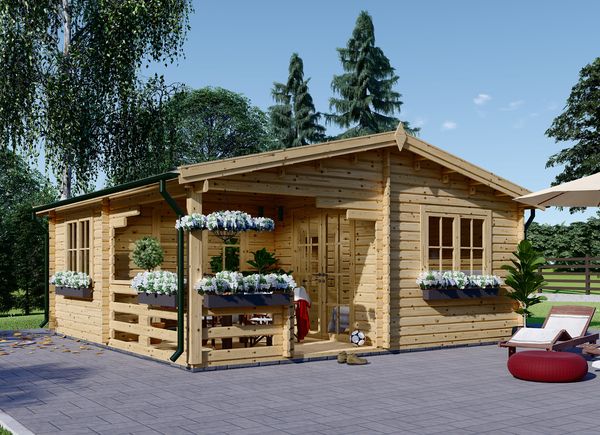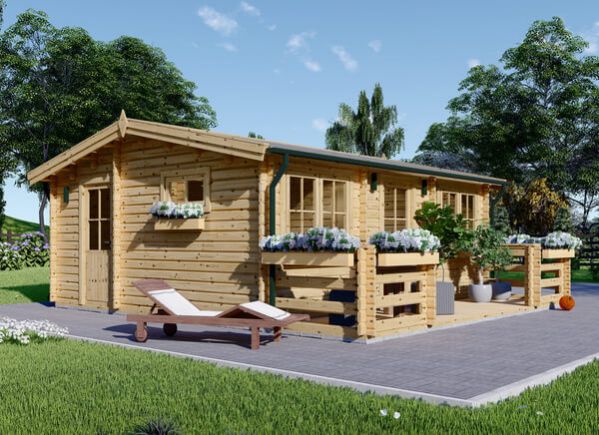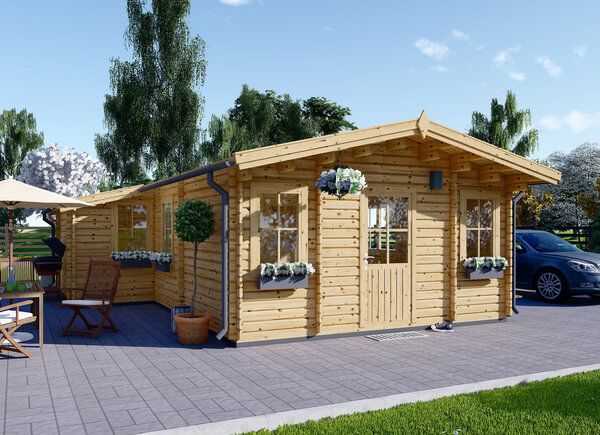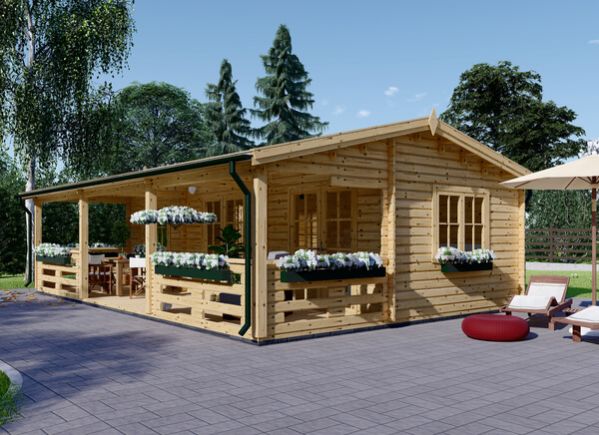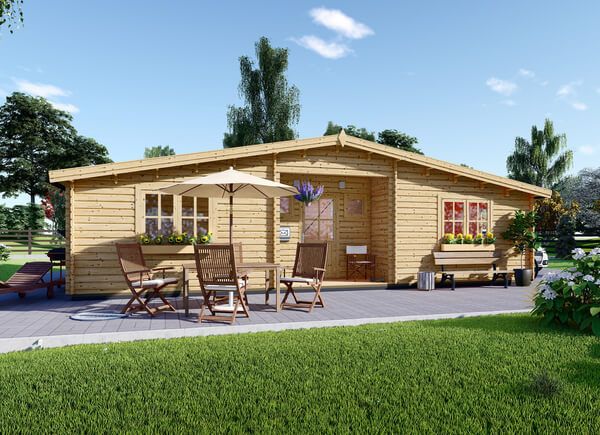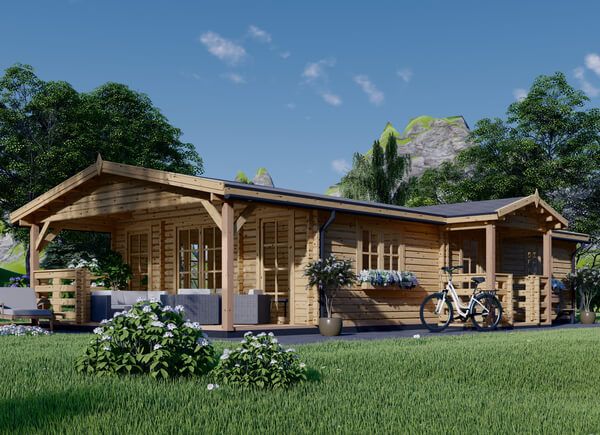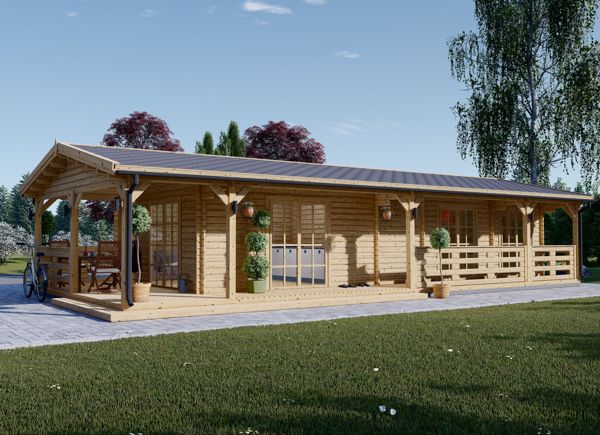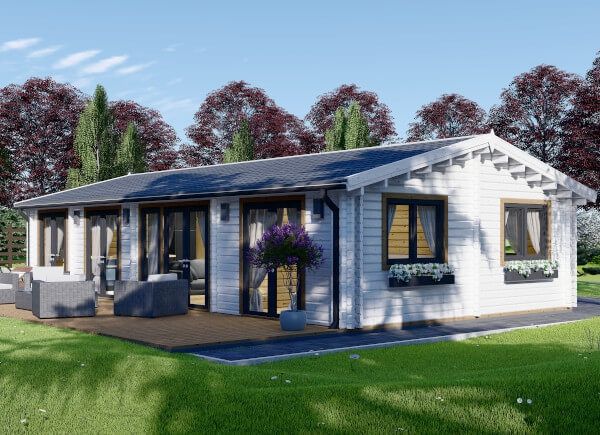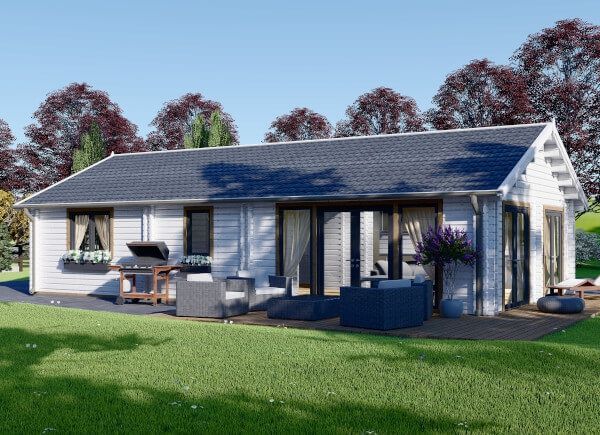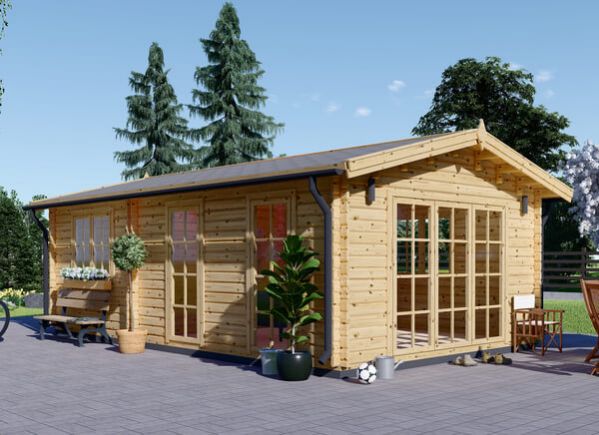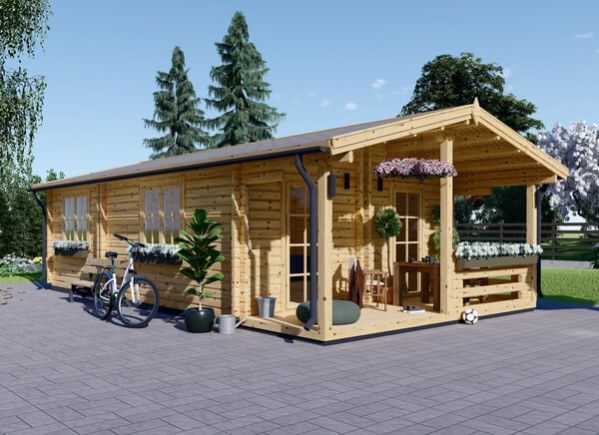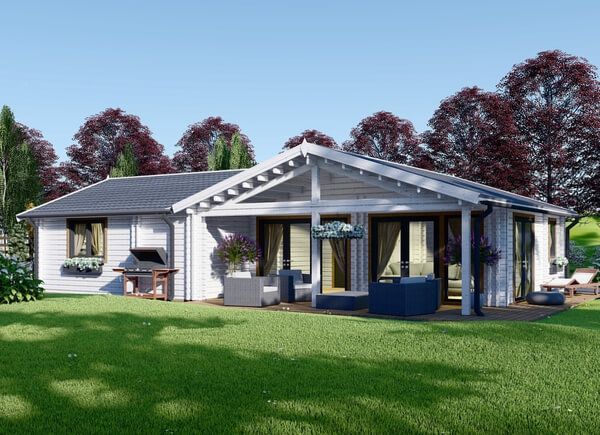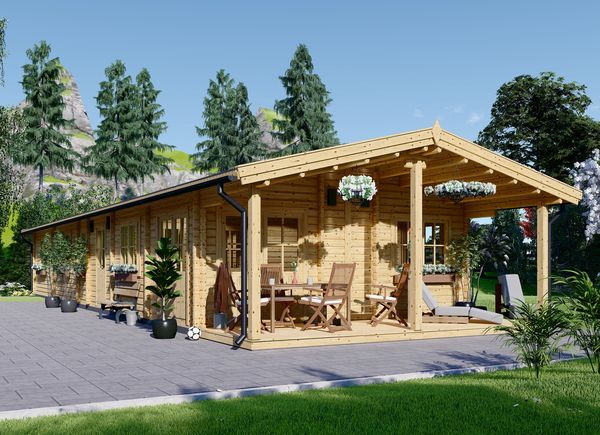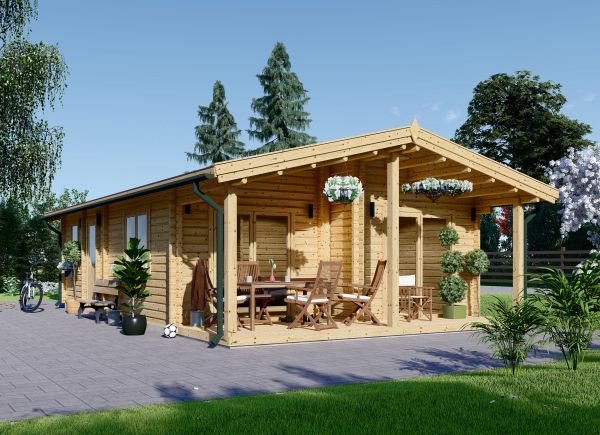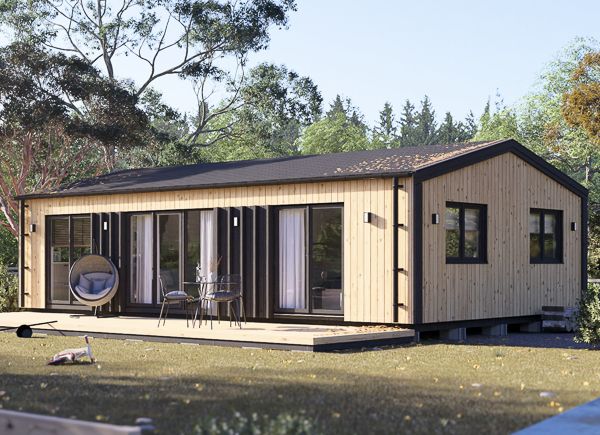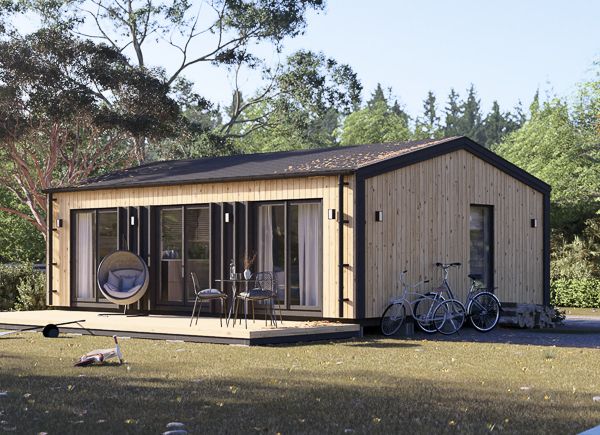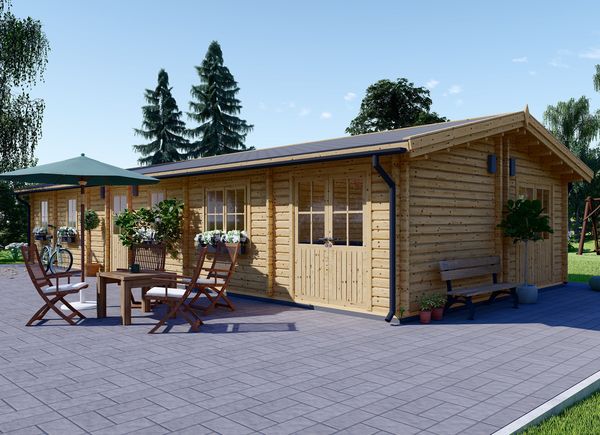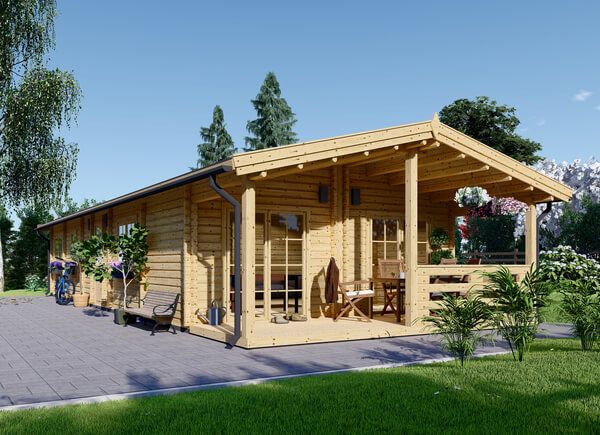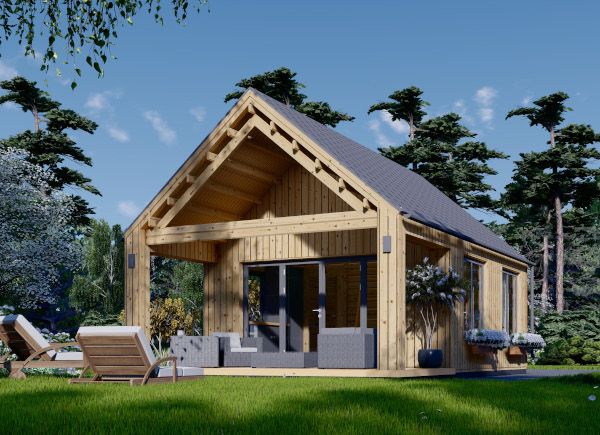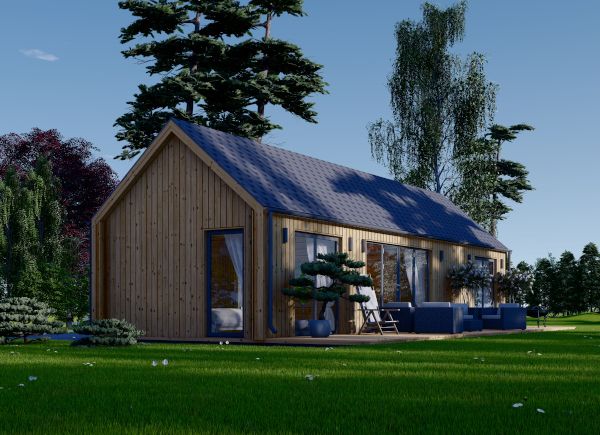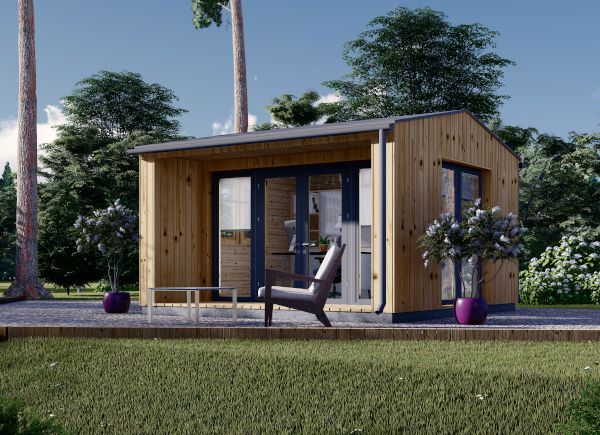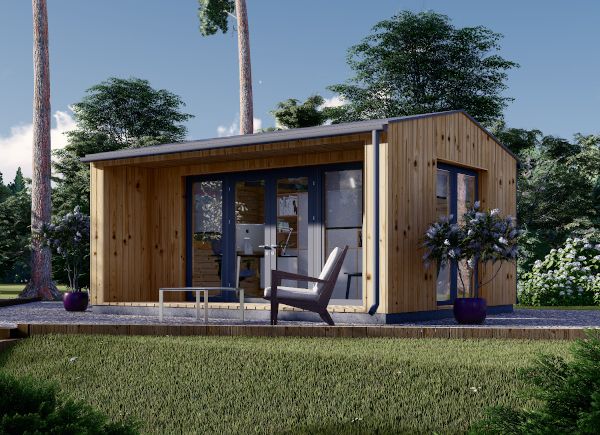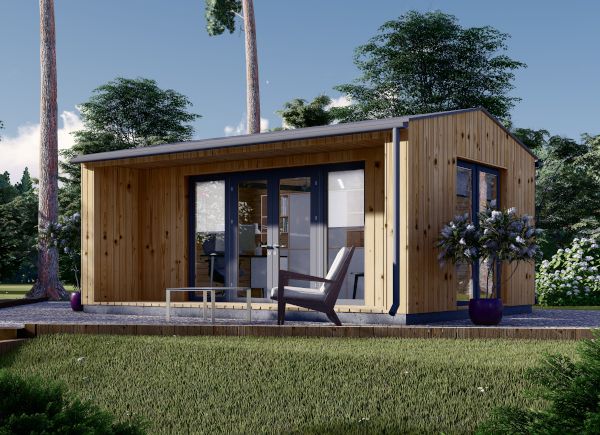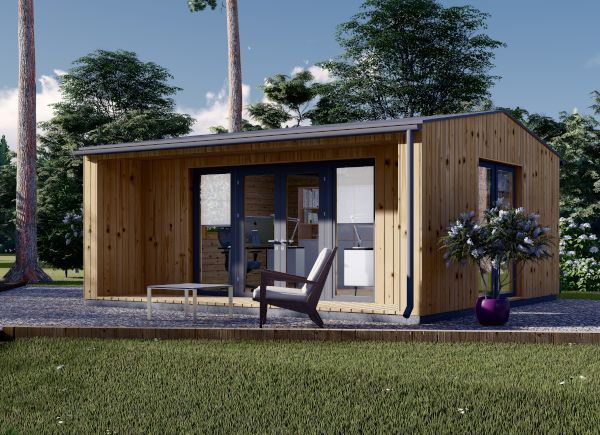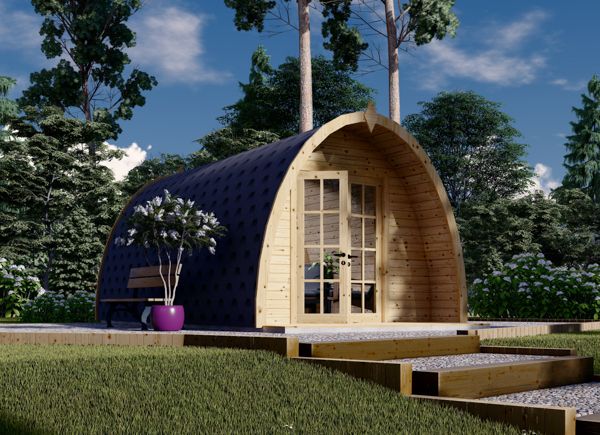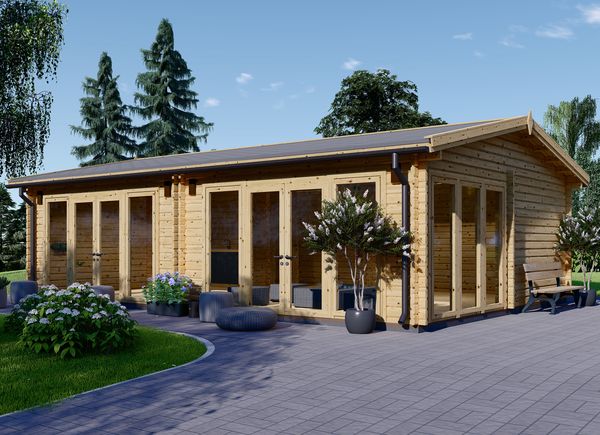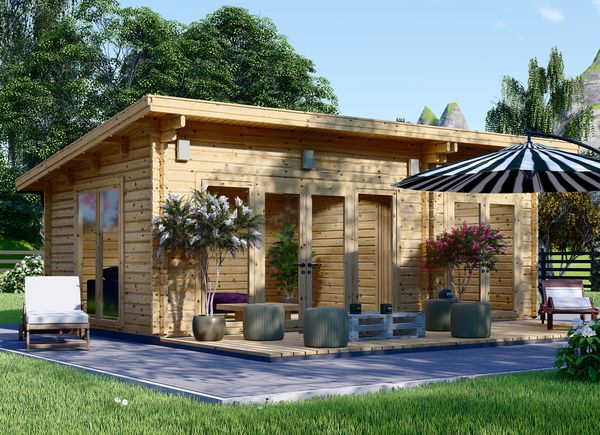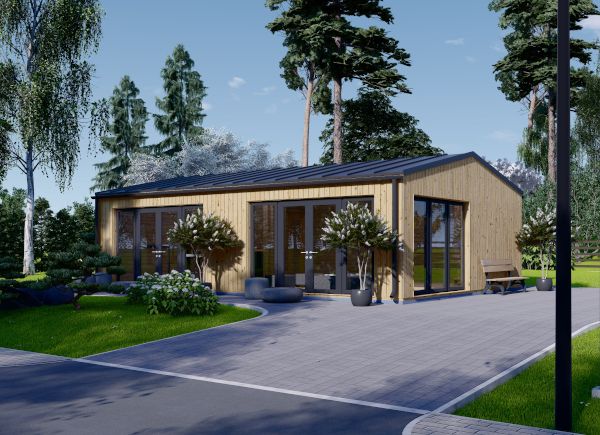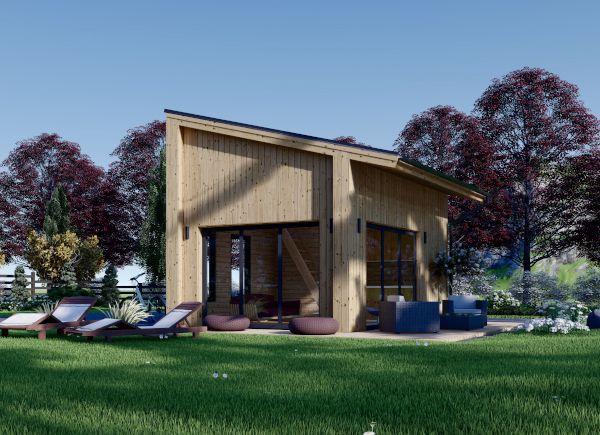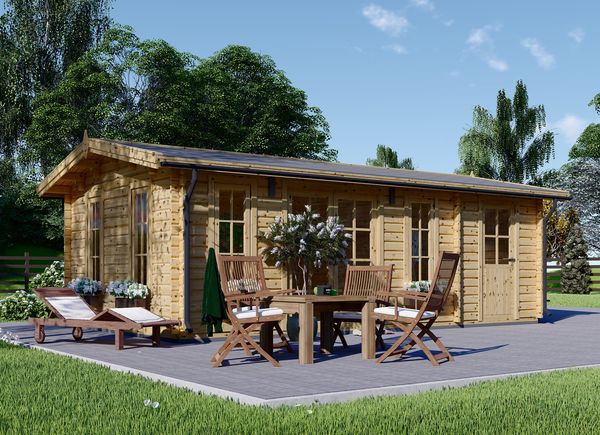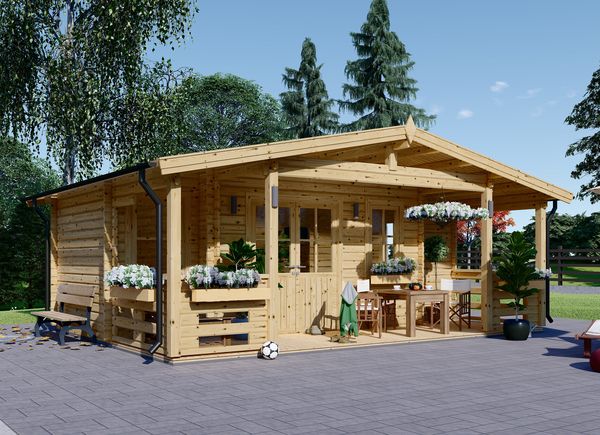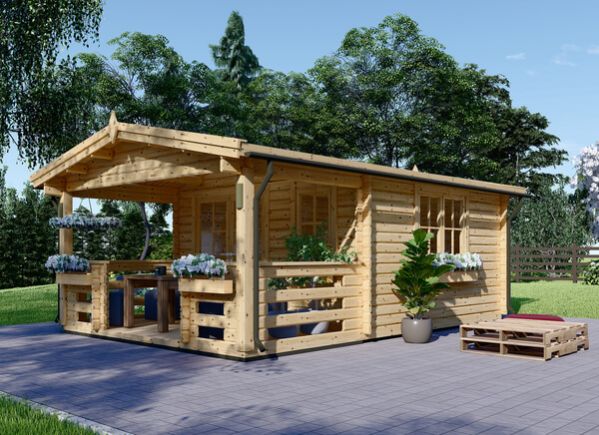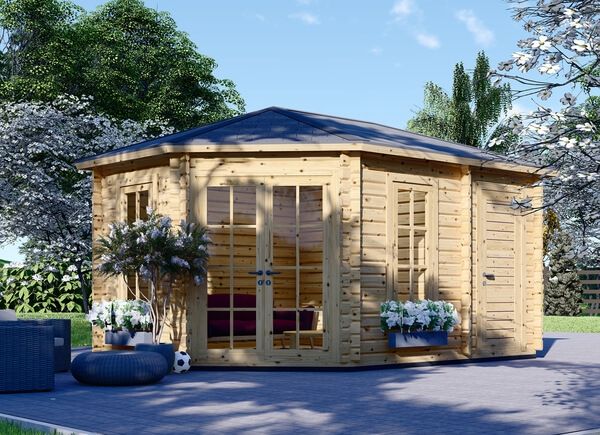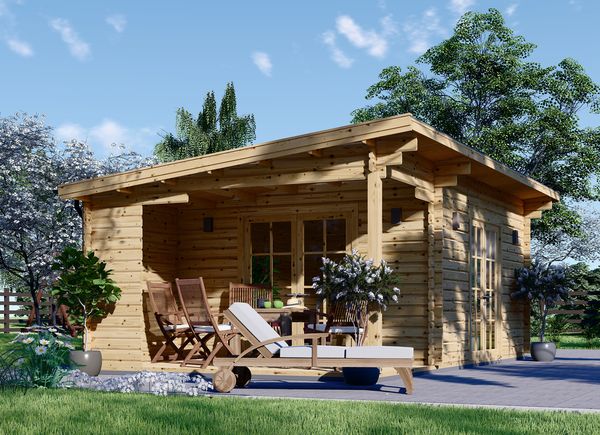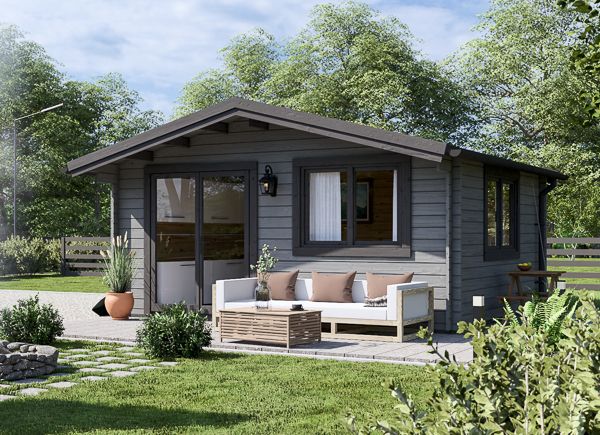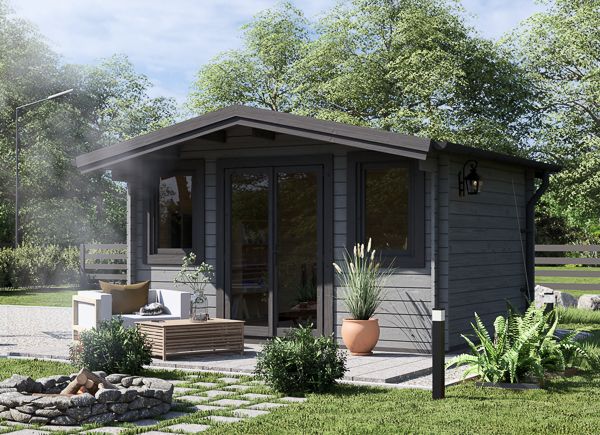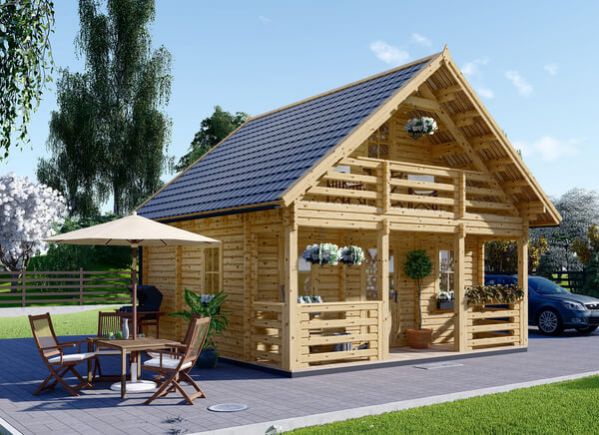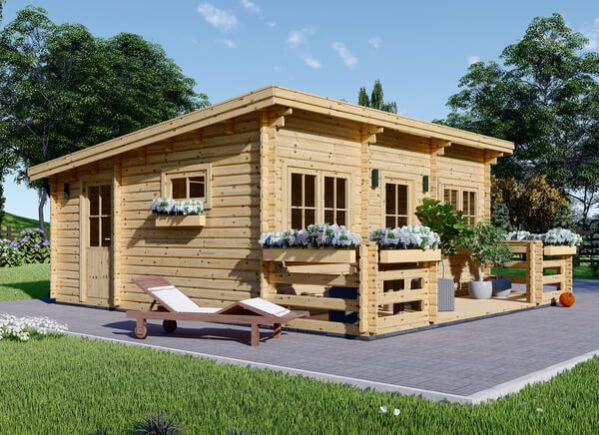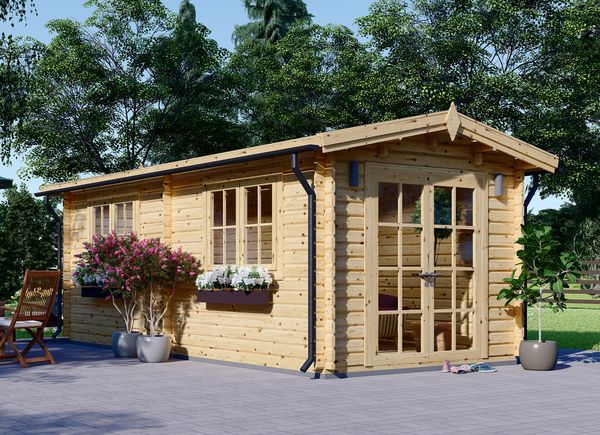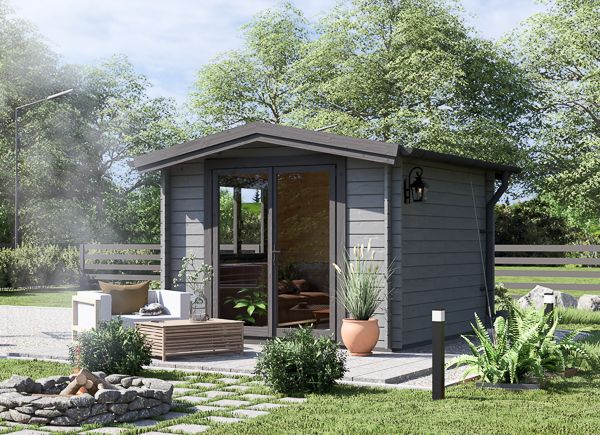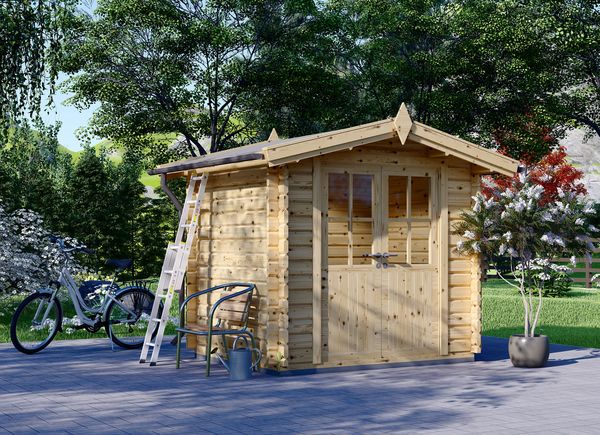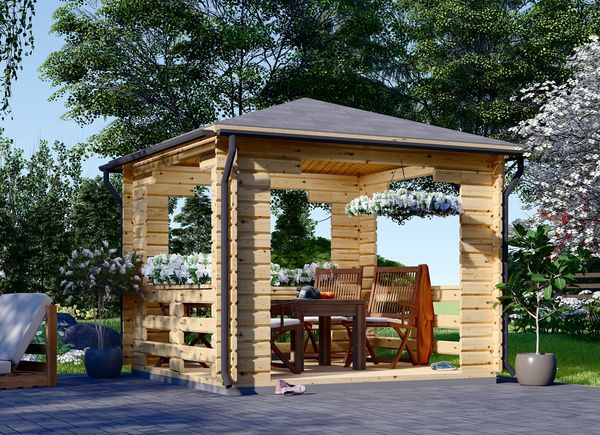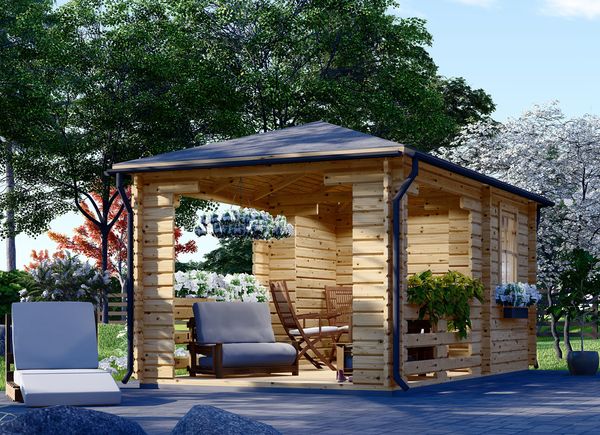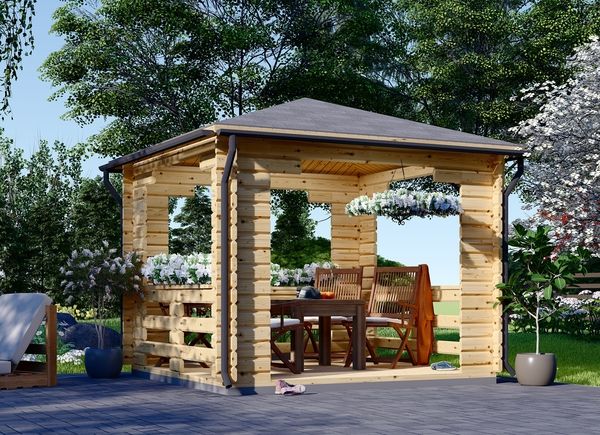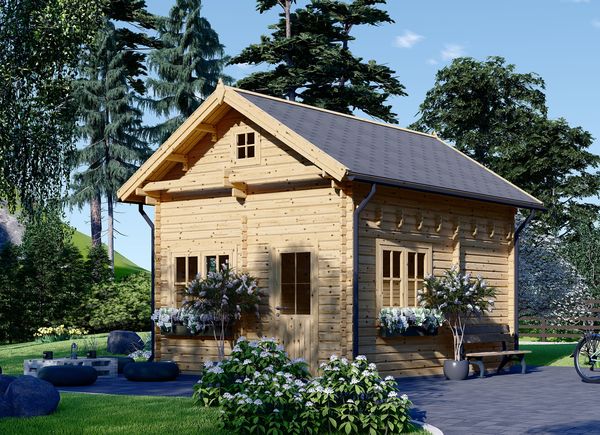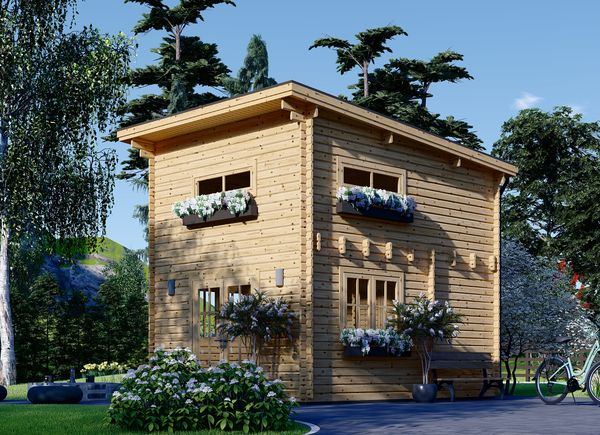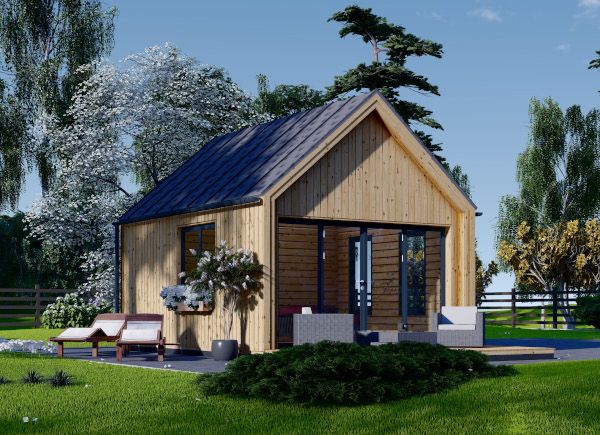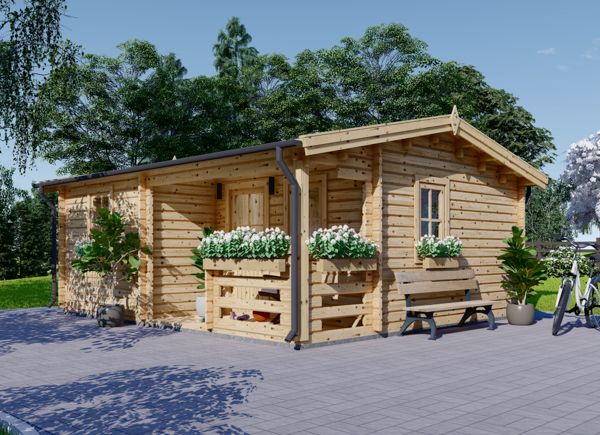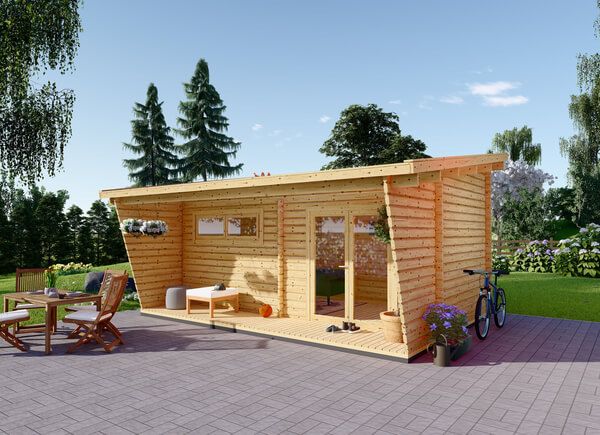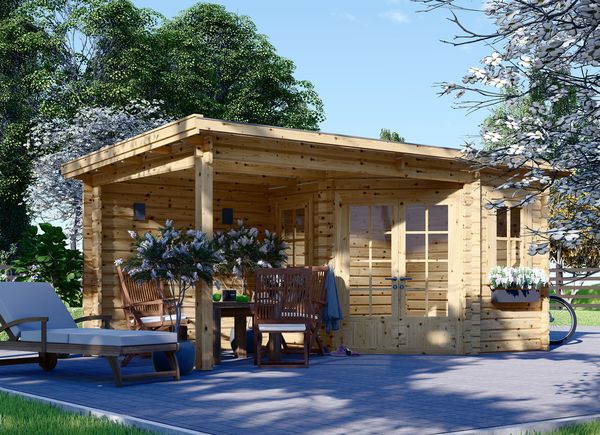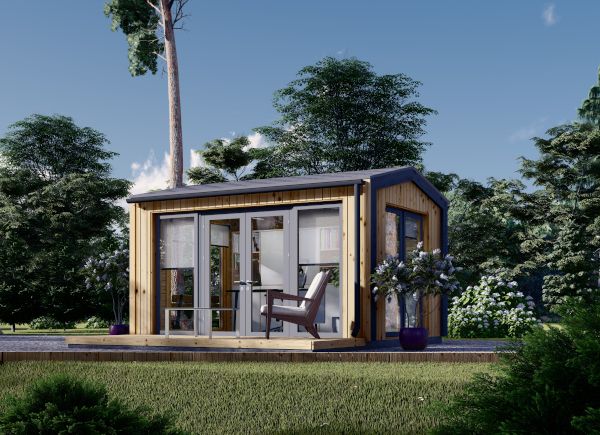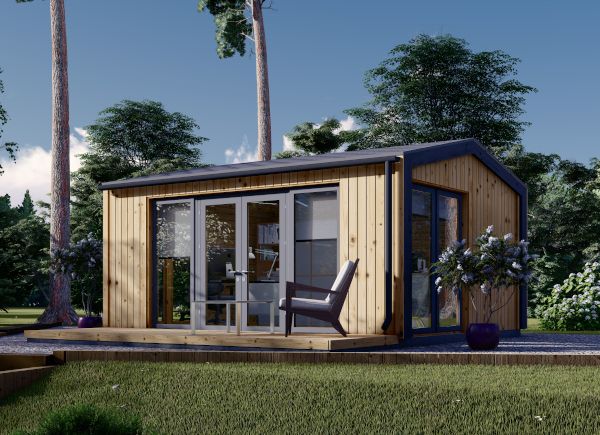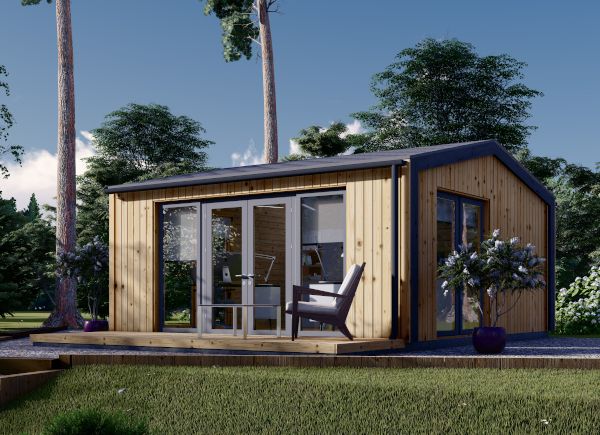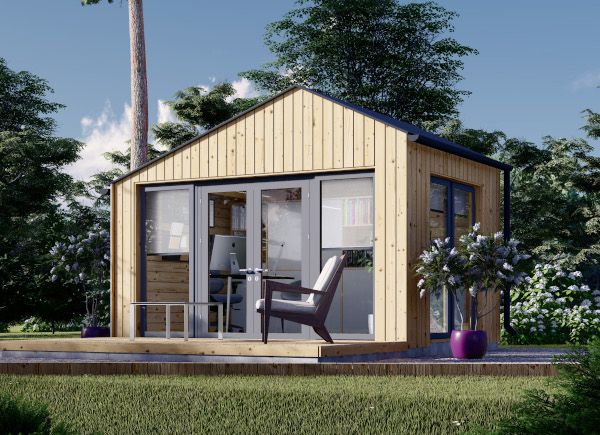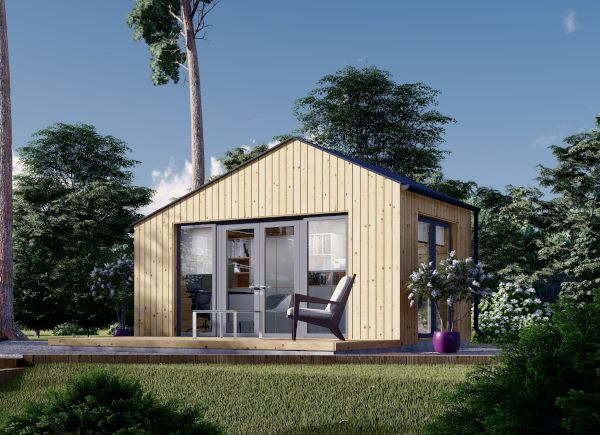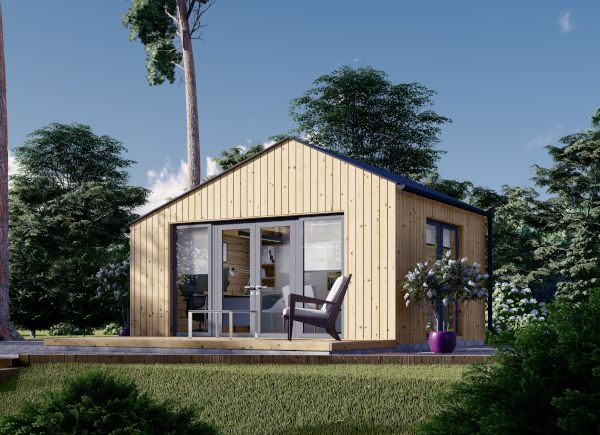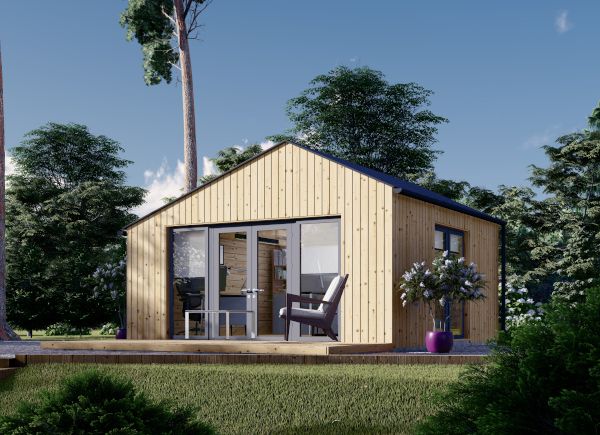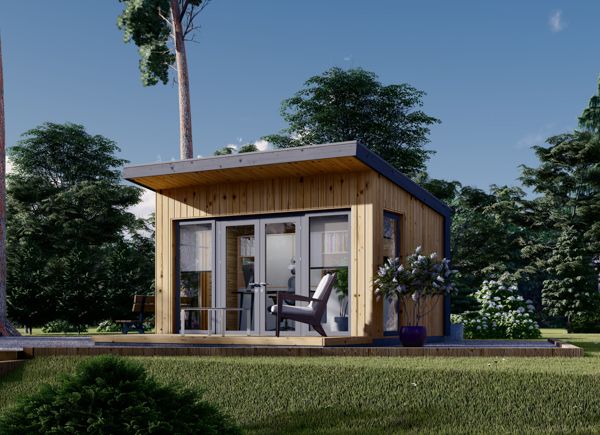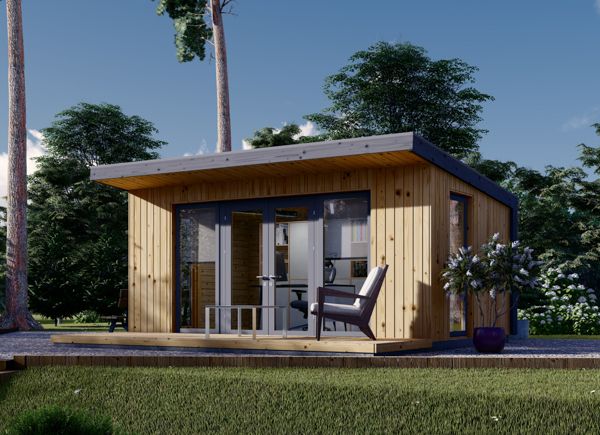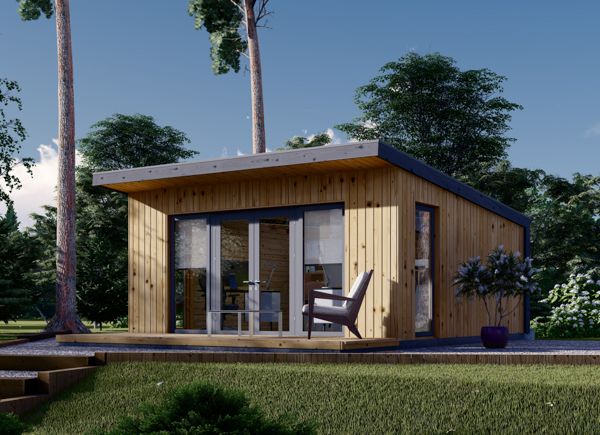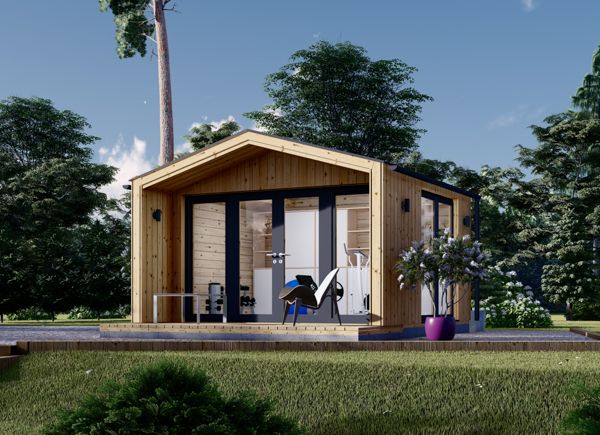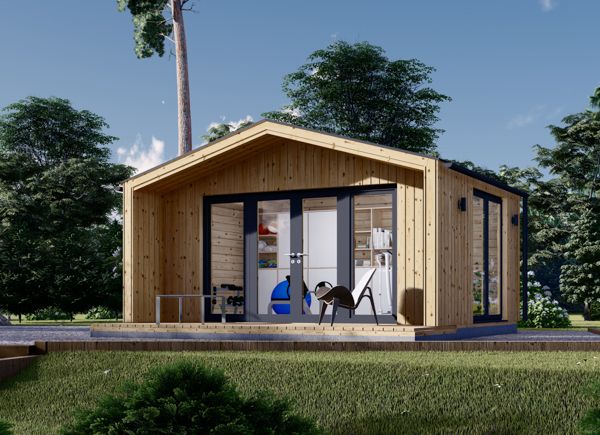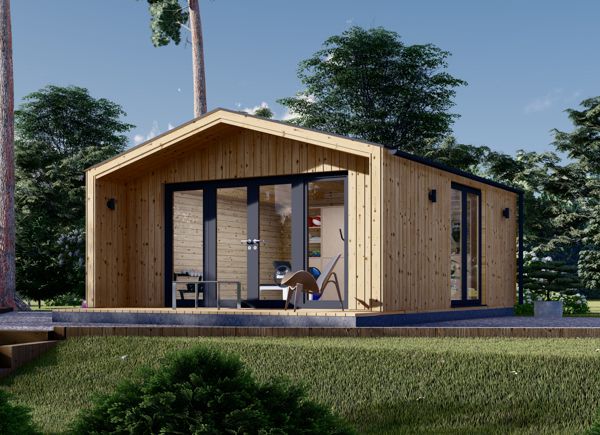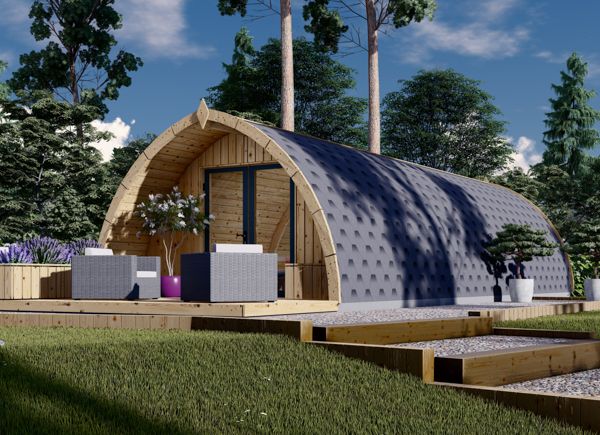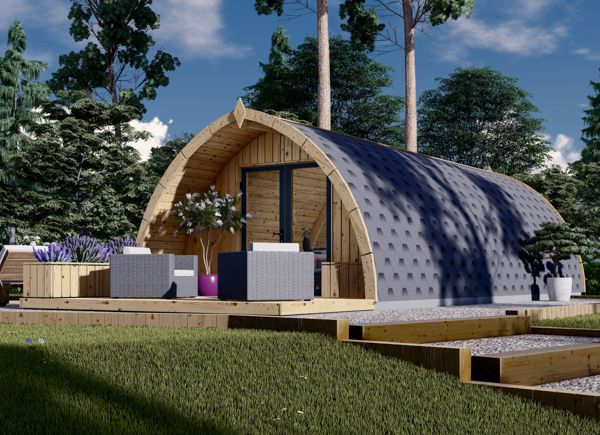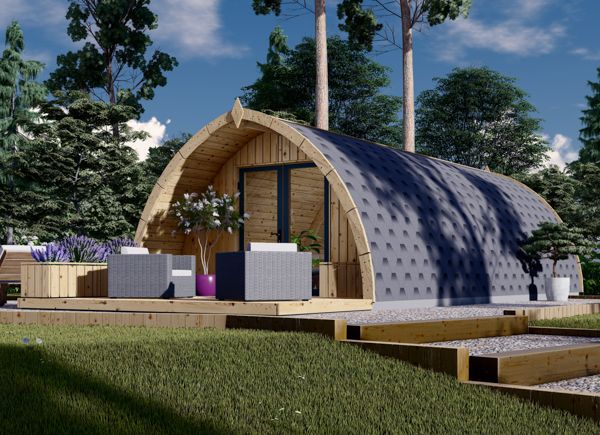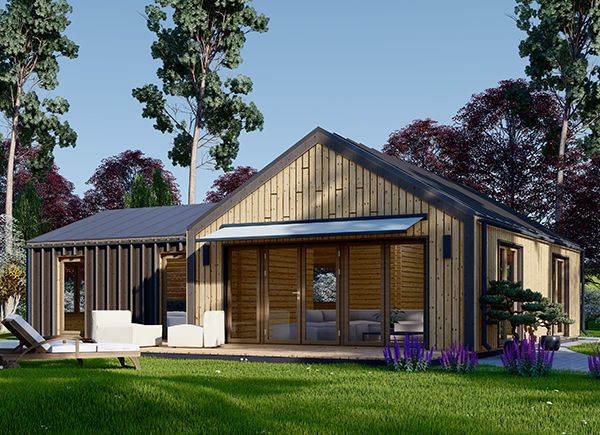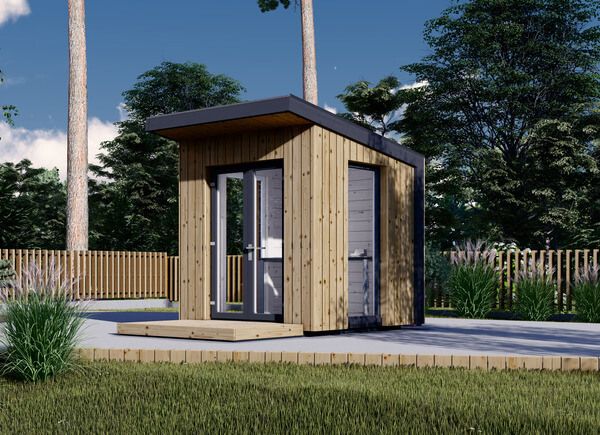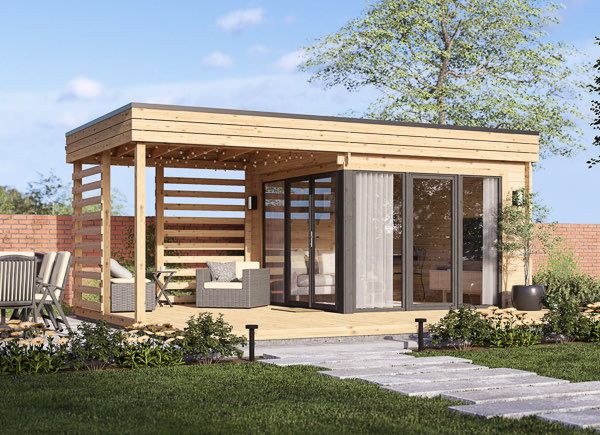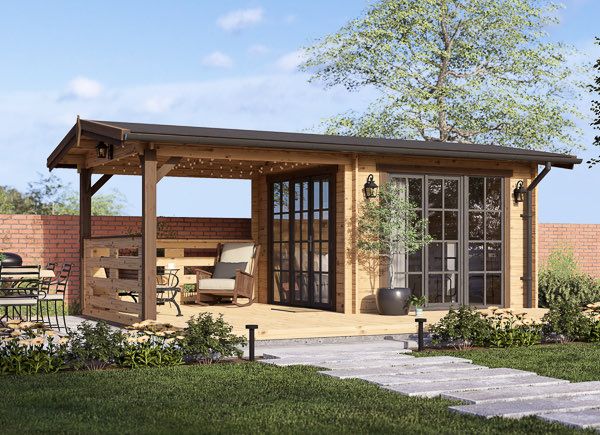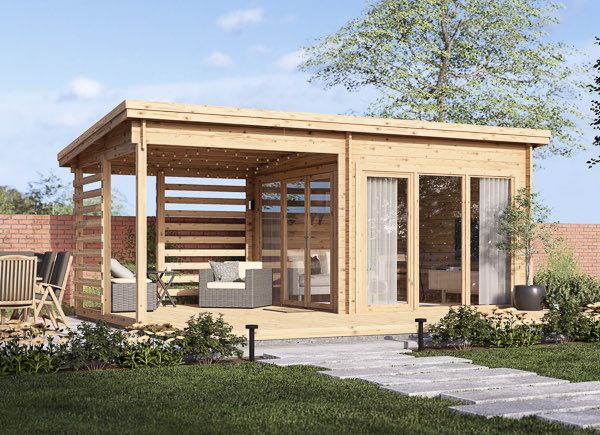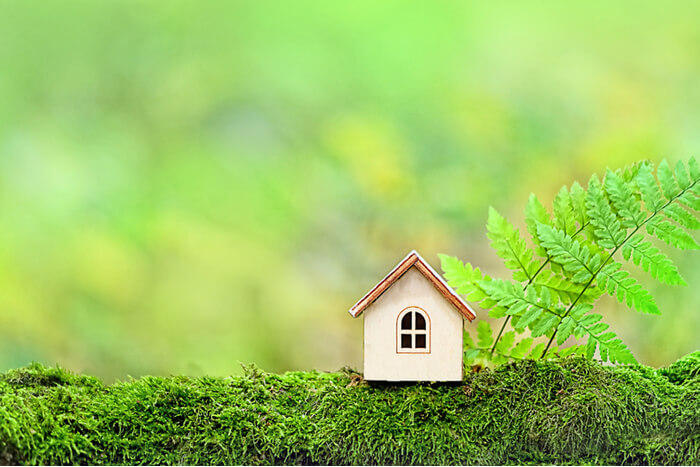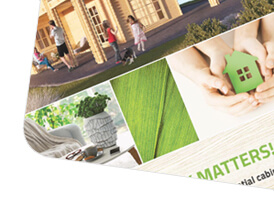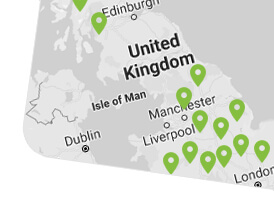Are you sure you want to perform this action?
Log Cabins
Selected
AGATA S is an exceptional wooden cabin, combining utmost functionality, timeless aesthetics and beautiful contemporary look. If you are searching for a compact house that would provide you with enough space for lounging indoors and outdoors and ensure efficient living and resting space arrangements, this could be the model to go for. Please note that this model in particular does not have the floor included in the price. However, the Terrano metal roofing is included in the final cost.
- 2 bedrooms
- 14 m² loft space
- Terrano metal roofing included in the price
Special Price: £18,575.00
A spacious, modern 3-bedroom log cabin house AGNES S has been designed for you to enjoy the natural light and surrounding landscape. Four large double glass doors on the front side of the building ensure easy access to almost any room. AGNES S is a perfect accommodation for 4 or more people, ensuring that each resident has their own private space. The building’s main point of attention is a centrally located living room, providing enough space for cooking, lounging, dining and communicating with your loved ones. Besides, this model also features anthracite PVC windows and doors that are included in the price.
- 3 bedrooms
- Anthracite PVC windows and doors
- Residential grade insulation level
Special Price: £39,585.00

Provide us with details about it. We'll be happy to help!
Write Us A MessageGet excited as this new addition to your garden space might change your lifestyle and level of comfort completely! This unique model from our contemporary garden building collection features an asymmetric roof, contemporary cladding and a distinctive modern touch. Wooden house TONIA S will provide you with so-much-needed space to expand your relaxation experience into new horizons. This model in particular has the Terrano metal roofing, white PVC windows and doors, plus floorboards (as well as the floor beams) included in the price. You also have space to add some insulation – up to 150 mm thickness material for the floor, 200 mm for the walls, and 300 mm for the roof.
- Stylish asymmetrical shape
- Terrano metal roofing
- White PVC windows and doors
Special Price: £11,639.00
Have you always wished for a personal space where you could leave all the worries behind and simply enjoy your day? One of our latest wooden house models EMMY S will make each moment you spend there an extraordinary one. Whether you decide to make it your living room extension, a comfortable home exercise area, or remote working space, this beautiful wooden structure will serve its best for you.
- Exceptional versatility
- Bright and cosy
Special Price: £4,395.00
Compact, cosy and bright wooden cabin OAK S, featuring classic design and form, could be a superb choice for a garden relaxation oasis or a summerhouse for shorter stays. Large windows optically extend the internal space and make this cabin a prime lounging spot. Enjoy the full potential of your garden by placing this lovely structure in your backyard! This model in particular has the floor included in the price.
- Multifunctional solution
- Bright and spacious
- The floor is included in the price
Special Price: £6,945.00

Provide us with details about it. We'll be happy to help!
Write Us A MessageCompact and minimalistic wooden cabin ESSEX S could become a cosy and functional addition to your backyard! This cabin could be used for various purposes: become a comfortable lounging room in the garden, a remote working room, storage space or a studio for your hobby. This specific model does not have the floor included in the price.
- Minimal and compact
- An open space of 17 m²
- The floor is not included in the price
Special Price: £4,390.00
A spacious, cosy, and versatile residential log cabin DONNA S is a charming classical style gem, combining utmost living comfort and unique architectural touches. Discover stylish exterior design details, a functional covered terrace area, spacious rooms, and a convenient layout, and make it a place to call home. You also have space to add some insulation – up to 150 mm thickness material for the walls.
- Elegant, versatile design
- 2 bedrooms
- 11.5 m² covered terrace
Special Price: £21,950.00
AGATA S is an exceptional wooden cabin, combining utmost functionality, timeless aesthetics and beautiful contemporary look. If you are searching for a compact house that would provide you with enough space for lounging indoors and outdoors and ensure efficient living and resting space arrangements, this could be the model to go for. Besides, this specific model has anthracite PVC windows & doors, plus interior cladding included in the price.
- 2 bedrooms
- 12 m² loft space
- PVC windows & doors, plus interior cladding
Special Price: £23,169.00
A classic style wooden house ANGERS S is a beautiful and budget-friendly model, that could bring you and your family many unforgettable moments. Featuring sturdy & reliable construction, efficiently laid out internal space and a charming spacious terrace, ANGERS S is often chosen as a family vacation house. Get ready to experience a slower, more natural pace of life in this magnificent building! Besides, this model has the floor, plus wooden windows and doors included in the price. There is also a possibility to insulate the walls and the roof in the future, as there is a gap between the walls fit for insulation material up to 100 mm.
- 11 m² loft as a bedroom space
- Extraordinary 19 m² terrace
- The walls and the roof can be insulated
Special Price: £15,950.00
Garden cabin OLIVIA S is a classical style masterpiece when it comes to its efficiently distributed internal layout and beautiful exterior aesthetics. Encompassing a charming covered terrace, this classical-style building could transform into your stylish lounging room, remote working space/meeting room, workshop or even a cosy vacation house for shorter stays. Finally, this model in particular includes the floor, windows, and doors, as well as a half-glass, half-wood entrance door in its price. The roof can also be insulated later with insulation material up to 100 mm.
- Compact, functional, and cosy
- 8 m² covered terrace
- The roof can be insulated
Special Price: £12,390.00
Wooden house SCOOT S is admired by many due to its classical style and aesthetically pleasing appearance. Simplistic in its purest form, this house is surprisingly full of delightful and functional elements, such as a sleeping loft for creating a dedicated bedroom space or stylish roof overhang, providing a so-much-needed shade outdoors. Please note that this specific model does not have the floor included in the price.
- 9 m² loft as a bedroom space
- Stylish roof overhang
- The floor is not included in the price
Special Price: £11,452.00
Aesthetically pleasing classical wooden shed PETER with an apex roof and stylish cross window double doors could be an excellent and practical addition to your garden space! This multifunctional structure can be arranged as a lounging room or a storage building, or a combination of both! A compact and functional design does not overload your space, yet provides enough room for arranging a relaxation corner or a storage area.
- Perfect for lounging or storage
- Practical double doors
- Stylish roof overhang
Special Price: £2,901.00
Aesthetically pleasing classical wooden shed PETER with an apex roof and stylish cross window double doors could be an excellent and practical addition to your garden space! This multifunctional structure can be arranged as a lounging room or a storage building, or a combination of both! A compact and functional design does not overload your space, yet provides enough room for arranging a relaxation corner or a storage area.
- Perfect for lounging or storage
- Practical double doors
- Stylish roof overhang
£2,589.00
- Compact and practical
- Perfect for storage
- Elegant flat roof
£2,558.00
- Made of Slow-Grown conifer timber
- Reinforced roof construction
Special Price: £2,650.00
Our classical style beauty – wooden cabin LILLE – certainly deserves your attention! Due to its compact form and precious design features, this model usually attracts customers who appreciate the simplicity and classical wooden aesthetics. This lovely cabin could serve as a functional storage solution, transform into your home office or lounging area for spending relaxed moments in.
- Lots of natural light inside
- Cute, minimalistic, and cosy
- Version with a flat roof available
£3,408.00
- Compact, cosy and bright
- Classical shape & design
- Insulated version available
£4,612.00
- Made of Slow-Grown conifer timber
- Reinforced roof construction
- 20mm Floor boards included
£3,764.00
- Lots of natural light inside
- Cute, minimalistic, and cosy
- Insulated version available
£5,050.00
Compact and minimalistic wooden cabin ESSEX could become a cosy and functional addition to your backyard! This cabin could be used for various purposes: become a comfortable lounging room in the garden, a remote working room, storage space or a studio for your hobby. If required, it can also be upgraded with a lovely wooden terrace, which would provide you with some additional functionality and comfort. For your utmost convenience, an insulated version of this model is available as well.
- Minimal and compact
- Lots of natural light inside
- Insulated version available
£5,333.00
- Multifunctional solution
- Bright and spacious
- Insulated version available
£5,123.00
- Made of Slow-Grown conifer timber
- Reinforced roof construction
- 20mm Floor boards included
£3,132.00
- Perfect for a hobby room or storage
- Double glazed windows and doors
- Version with a flat roof available
Special Price: £3,764.00
- Made of Slow-Grown conifer timber
- Reinforced roof construction
- 20mm Floor boards included
£2,361.00
The wooden shed MODERN has a unique roof design and makes the ideal place to store your gardening tools. Its attractive design will suit any garden.
- Made of Slow-Grown conifer timber
- Reinforced roof construction
- 20mm Floor boards included
£1,873.00
Having a dedicated storage space could ease your life quite a bit! Unclutter your garden area and living surroundings by storing all your tools and equipment in our compact and stylish garden shed PALMA. A practical and lovely choice, which will not overload your backyard, yet provide you with an extensive amount of storage room. What is more, you could arrange a gorgeous lounging area in there as well!
- Perfect for lounging or storage
- Practical double doors
- Stylish roof overhang
£3,687.00
Simple, compact and elegant garden log cabin DREUX provides enough space to securely store all your garden equipment, perform your hobby or create a delightful sunlight-filled space in the garden to simply cosily rest and relax. Sturdiness and ease of construction make this traditional-style garden cabin a truly desired architectural piece, highly appreciated by many.
- Perfect for a hobby room or storage
- Double glazed windows and doors
- 66 mm version available
Special Price: £4,458.00
- Practical and affordable solution
- Ideal for camping or glamping
- Available in several size options
£2,495.00
This commercial kiosk is all you need for your business or your gatherings to thrive! Now you can use it to sell all kinds of goods or to promote your special offers. Design this kiosk in a way that best represents you, and attract your customers with smells that tingle the senses or a look that is worthy of a double take. You can also use this kiosk to elevate your hosting skills and the atmosphere of your garden parties. In any case, prepare for a line of admiring customers!
- 3 adjustable openings
- Size options: 3x3 ; 5x3 ; 4x4
- Compact and practical
£2,345.00
This commercial kiosk is all you need for your business or your gatherings to thrive! Now you can use it to sell all kinds of goods or to promote your special offers. Design this kiosk in a way that best represents you, and attract your customers with smells that tingle the senses or a look that is worthy of a double take. You can also use this kiosk to elevate your hosting skills and the atmosphere of your garden parties. In any case, prepare for a line of admiring customers!
- 3 adjustable openings
- Size options: 3x3 ; 5x3 ; 4x4
- Compact and practical
£3,384.00
This commercial kiosk is all you need for your business or your gatherings to thrive! Now you can use it to sell all kinds of goods or to promote your special offers. Design this kiosk in a way that best represents you, and attract your customers with smells that tingle the senses or a look that is worthy of a double take. You can also use this kiosk to elevate your hosting skills and the atmosphere of your garden parties. In any case, prepare for a line of admiring customers!
- 2 adjustable openings
- Size options: 3x3 ; 5x3 ; 4x4
- Compact and practical
£3,290.00
If you're looking for a garden cabin that can act as a storage area and a lounging spot, LARISSA is definitely a great option. This model includes a lovely 7 m² terrace that you can spruce up with some outdoor furniture and invite some guests (or your neighbours) over. Kick back and relax in your own space outside with a covered roof, and if the weather is a bit chilly, you can always warm up inside. With LARISSA, the choice is yours!
- 7 m² covered terrace
- Single - glazed windows
- Made from slow-grown conifer timber
£2,424.00
Wooden cabin WISSOUS is a cosy & relaxing retreat, offering an outstanding indoor and outdoor space balance. Large cross windows and double entrance doors ensure plenty of natural light inside, while a stylish roof overhang provides a so-much-needed shade for placing a lounging chair or a dinner table underneath. For your utmost convenience, an insulated version of this model is available as well.
- Compact, cosy and bright
- Classical shape & design
- Size options: 5x3; 5x4; 5x5; 5x6
£3,486.00
Our classical style beauty – wooden cabin LILLE – certainly deserves your attention! Due to its compact form and precious design features, this model usually attracts customers who appreciate the simplicity and classical wooden aesthetics. This lovely cabin could serve as a functional storage solution, transform into your home office or lounging area for spending relaxed moments in.
- Lots of natural light inside
- Cute, minimalistic, and cosy
- Version with a flat roof available
£3,447.00
- Practical and affordable solution
- Ideal for camping or glamping
- Available in several size options
£2,957.00
- Practical and affordable solution
- Ideal for camping or glamping
- Available in several size options
£4,008.00
- 15 m² loft as a bedroom space
- Delightful 10 m² terrace (optional feature)
- Insulated version available
£10,938.00
- Lots of natural light inside
- Cute, minimalistic, and cosy
- Multifunctional solution
£5,123.00
The garden shed MINI is perfect for keeping all your gardening tools, garden furniture, and equipment safe. If you want to keep your house spacious, there's no better way to declutter than to put lesser-used items in a shed right outside. This practical yet stylish model can be a real lifesaver!
- Compact
- Secure double doors
- Quick & easy assembly
£2,345.00
Garden cabin PIA is a true delight if you are looking for a gorgeous contemporary solution for your garden space. Stylish, cosy and bright, it could be a great option for a lovely garden studio or office space. For your utmost convenience, an insulated version of this model is available as well.
- Lovely 3.30 m² terrace
- Size options: 4x3 m; 5x3 m; 5x4 m; 5x5
- Insulated version available
£7,082.00
Discover classic style granny annexe ARGO M-N and enjoy minimalistic wooden aesthetics. This comfortable and practical model could provide you with a valuable space extension close to your primary residence. It may also serve you as a family vacation spot throughout the year, if you choose to insulate it with all-around 100 mm thick insulation. ARGO M-N is a lovely model for staying in and enjoying quality time with family and friends whenever you wish. Please note that this particular model has spent a while in stock and may have some damaged parts.
- Double-glazed windows and doors
- A perfect residential space extension
- B-ware: the model spent a while in stock
Special Price: £17,995.00
- Also available in 6x6m
- Dedicated bathroom space
- Insulated version available
Special Price: £5,647.00
Wooden cabin WISSOUS is a cosy & relaxing retreat, offering an outstanding indoor and outdoor space balance. Large cross windows and double entrance doors ensure plenty of natural light inside, while a stylish roof overhang provides a so-much-needed shade for placing a lounging chair or a dinner table underneath. For your utmost convenience, an insulated version of this model is available as well.
- Compact, cosy and bright
- Classical shape & design
- Insulated version available
Special Price: £5,324.00
Our classical style beauty – wooden cabin LILLE – certainly deserves your attention! Due to its traditional form and precious design features, this model usually attracts customers who appreciate the simplicity and classical wooden aesthetics. This bright and spacious cabin could transform into your home office, lounging area or a stylish summerhouse for spending relaxed moments with your family in.
- Lots of natural light inside
- Cute, minimalistic, and cosy
- Multifunctional solution
Special Price: £5,253.00
Wooden cabin DREUX has all the qualities to become your perfect escape spot, a dream lounging space or a base for a wide range of activities. This classical style, functional, and eco-friendly structure could transform into a charming workshop, hobby room or a superb garden relaxation area. Sturdiness and ease of construction make this traditional-style garden cabin a truly desired architectural piece, highly appreciated by many. Customize the cabin's interior to fit your individual needs and enjoy the experience of utmost functionality and comfort. For your utmost convenience, an insulated version of this model is available as well.
- Perfect for a hobby room or storage
- Size options: 5x4 ; 5x5 ; 6x6
- Insulated version available
Special Price: £5,217.00
- Perfect for a hobby room or storage
- Size options: 5x4 ; 6x6
- Insulated version available
Special Price: £4,471.00
Classical shaped wooden cabin ELEONORA should grab the attention of traditional wooden style admirers in search of a perfect relaxation space in their garden. This compact structure could serve you a multitude of purposes: from a living room extension in your backyard to a functional space for storing all your garden utensils and arranging a hobby room or workshop in.
- Two separate rooms
- Bright and cosy internal area
- Fits into a narrower plot
Special Price: £5,252.00
- Bright and cosy
- Double glazed windows and doors
- Insulated version available
£3,447.00
- Perfect for a hobby room or storage
- Double glazed windows and doors
- Version with an apex roof available
£3,368.00
- Compact, cosy and bright
- Classical shape & design
- Insulated version available
£6,848.00
- Available with a flat roof
- 10 m² covered terrace
- Insulated version available
£18,147.00
- Spacious and bright
- Stylish roof overhang
- Insulated version available
£6,037.00
- Exceptionally bright internal area
- Highly multifunctional space
- Insulated version available
£5,732.00
Has your house been feeling cramped lately? Building a living space extension in your backyard could save you a lot of hassle when you need some extra room for yourself, visiting friends or a comfortable place of residence for your family members to stay nearby. Wooden house LINCOLN M features a spacious living room area, two mid-size bedrooms, a dedicated bathroom area, and an additional compact space for storage. All you might need from a beautiful traditional style wooden house, and more! For your utmost convenience, an insulated version of this model is available as well.
Important: this mobile cabin home meets all the requirements of the 1968 Caravan Act – therefore, no Planning Permission is usually required if you want to build it within the garden of your existing dwelling to be used as an extra space next to the main house. However, we highly recommend checking with the local planning department before installing it.
- 2 bedrooms
- Spacious and practical
- Insulated version available
£30,176.00
- Compact and cosy
- Perfect for storage or workshop
- Also available in 4x4 m
£3,290.00
- Spacious and bright
- Stylish roof overhang
- Insulated version available
£3,919.00
- Compact and cosy
- Perfect for storage or workshop
- Also available in 3x3 m
£4,549.00
- Roof overhang serving as a pergola
- Bright, spacious & cosy
- Insulated version available
£4,521.00
- 10 m² loft as a bedroom space
- Stylish roof overhang
- Insulated version available
£10,467.00
Wooden cabin DREUX has all the qualities to become your perfect escape spot, a dream lounging space or a base for a wide range of activities. This classical style, functional, and eco-friendly structure could transform into a charming workshop, hobby room or a superb garden relaxation area. Sturdiness and ease of construction make this traditional-style garden cabin a truly desired architectural piece, highly appreciated by many. Customize the cabin's interior to fit your individual needs and enjoy the experience of utmost functionality and comfort.
- Perfect for a hobby room or storage
- Double glazed windows and doors
- Version with an apex roof available
Special Price: £4,546.00
OSLO is a classical style wooden shed with a nice architectural tweak – a compact porch in front of the entrance door. This makes it an exceptional addition to our garden building collection, highly appreciated among those looking for a more interesting design solution. 20 m² internal area is all yours to arrange depending on your personal requirements. For your utmost convenience, an insulated version of this model is available as well.
- Unique architectural shape
- Stylish little porch
- Insulated version available
Special Price: £4,537.00
- Bright and cosy
- Multifunctional solution
- Insulated version available
£5,077.00
- Double-glazed windows and doors
- Bright and cosy
- Perfect for lounging and relaxation
£5,418.00
- Cosy covered terrace
- Lots of natural light inside
- Insulated version available
£6,269.00
- Convenient two-storey structure
- 8 m² covered terrace
- Double glazed windows and doors
£11,404.00
- Spacious and cosy
- Roomy and versatile
- Insulated version available
£6,879.00
- 7 m² covered terrace
- 2 separate indoor spaces
- Insulated version available
£5,944.00
- Perfect for a hobby room or storage
- Size options: 5x4 ; 5x5 ; 6x6
- Insulated version available
£7,789.00
- Also available in 5x5m
- Dedicated bathroom space
- Insulated version available
£8,410.00
- 12,5 m² covered terrace
- 3 separate spaces
- Double glazed windows and doors
£8,452.00
- 11 m² covered terrace
- Light-filled internal space
- Insulated version available
£6,189.00
- Compact, functional, and cosy
- 8 m² covered terrace
- Insulated version available
£8,957.00
- Available with a flat roof
- A lovely 9 m² terrace
- Insulated version available
£9,658.00
- Three separate rooms
- 18 m² living and dining space
- Insulated version available
£12,495.00
- 2 separate rooms
- Spacious and cosy
- Insulated version available
£6,129.00
- Cosy and functional
- 5 m² shed attached
- Double-glazed windows and doors
£7,080.00
- Made of Slow-Grown conifer timber
- Reinforced roof construction
- Double-glazing
£7,120.00
- 13 m² loft as a bedroom space
- Extraordinary 19 m² terrace
- Insulated version available
£13,885.00
- 1 bedroom
- 20 m² covered terrace
- Insulated version available
£13,029.00
- 2 bedrooms
- Lots of natural light inside
- Insulated version available
£16,798.00
- 2 bedrooms + one spare room
- 23.5 m² living room area
- Insulated version available
£19,916.00
- 2 bedrooms
- Spacious & functional layout
- Insulated version available
£15,823.00
- 2 bedrooms
- 11.5 m² covered terrace
- Insulated version available
£18,219.00
- 2 bedrooms
- Gorgeous 29 m² terrace
- Insulated version available
£27,477.00
- Thermally insulated
- 3 bedrooms
- Lovely 30 m² terrace
£32,486.00
- Thermally insulated
- 2 bedrooms
- 25 m² living room
£30,415.00
Compact, welcoming, and cosy wooden house MAX M seems to be specifically created to become your favourite lounging space in the garden, allowing you to admire the beauty you’ve created in your surroundings. It could even transform into a temporary accommodation for your guests or family members visiting for the weekend. If properly insulated, such a house could serve as an independent living space as well. For your utmost convenience, an insulated version of this model is available as well.
Important: this mobile cabin home meets all the requirements of the 1968 Caravan Act – therefore, no Planning Permission is usually required if you want to build it within the garden of your existing dwelling to be used as an extra space next to the main house. However, we highly recommend checking with the local planning department before installing it.
- 3 separate spaces
- Bright and cosy
- Insulated version available
£11,097.00
Discover a classical style wooden house ARGO M and enjoy minimalistic wooden aesthetics in your surroundings. This highly functional, comfortable and practical model could provide you with a valuable living space extension close to your primary residence or, if reliably thermally insulated, could serve you as an all-year-round family vacation spot. For your utmost convenience, an insulated version of this model is available as well.
Important: this mobile cabin home meets all the requirements of the 1968 Caravan Act – therefore, no Planning Permission is usually required if you want to build it within the garden of your existing dwelling to be used as an extra space next to the main house. However, we highly recommend checking with the local planning department before installing it.
- 8 m² terrace for outdoor lounging
- A perfect residential space extension
- Insulated version available
£14,763.00
Discover a classical style wooden house ARGO M and enjoy minimalistic wooden aesthetics in your surroundings. This highly functional, comfortable and practical model could provide you with a valuable living space extension close to your primary residence or, if reliably thermally insulated, could serve you as an all-year-round family vacation spot.
Important: this mobile cabin home meets all the requirements of the 1968 Caravan Act – therefore, no Planning Permission is usually required if you want to build it within the garden of your existing dwelling to be used as an extra space next to the main house. However, we highly recommend checking with the local planning department before installing it.
- Thermally insulated
- 8 m² terrace for outdoor lounging
- A perfect residential space extension
£27,603.00
- Thermally insulated
- A huge 28 m² living room
- 2 spacious bedrooms
£42,748.00
One of our largest wooden house models – granny annexe BOSTON – could be the perfect secondary accommodation for your entire family and friends during cosy weekend stays or fun family celebrations. Due to its functionality and vast interior space, this gorgeous prefabricated building, made of natural conifer timber, have enormous potential of becoming your family’s summerhouse or even a primary living space. Spend valuable time together, surrounded by the best company, nature and fresh air. For your utmost convenience, an insulated version of this model is available as well.
Important: this mobile cabin home meets all the requirements of the 1968 Caravan Act – therefore, no Planning Permission is usually required if you want to build it within the garden of your existing dwelling to be used as an extra space next to the main house. However, we highly recommend checking with the local planning department before installing it.
- Spacious covered terrace
- 30 m² living room
- Insulated version available
£47,645.00
Single-storey mobile house MEGAN M, covering 60 m² of internal space, including a charming, covered terrace, is a compact and cosy wooden solution, providing the required qualities to become one’s comfortable living space. If you want to stay warm and comfortable in this wooden beauty all year round, choosing an insulated version is a must! Conifer timber has natural insulation properties – upgrade it with an additional thermal insulation package and never look back! For your utmost convenience, an insulated version of this model is available as well.
Important: this mobile cabin home meets all the requirements of the 1968 Caravan Act – therefore, no Planning Permission is usually required if you want to build it within the garden of your existing dwelling to be used as an extra space next to the main house. However, we highly recommend checking with the local planning department before installing it.
- Stylish 8m² covered terrace
- 24 m² living room area
- Insulated version available
£26,010.00
An insulated two-bedroom cabin with a cosy living room could become a perfect place of residence for a family with kids. Also, a great option for elderly grandparents, who love having their grandchildren over and comfortably spending time together, to reside next to the main house.
Important: this mobile cabin home meets all the requirements of the 1968 Caravan Act – therefore, no Planning Permission is usually required if you want to build it within the garden of your existing dwelling to be used as an extra space next to the main house. However, we highly recommend checking with the local planning department before installing it.
- Two-bedroom cabin
- Insulated throughout
- Contemporary vertical cladding
Special Price: £33,147.00
One of our newest models – a charming insulated one-bedroom granny annexe – provides lots of space to comfortably reside in all-year-long. Whether you are planning to live there yourself or want your loved ones to stay within easy reach, this cabin will work just great for a variety of purposes and applications.
Important: this mobile cabin home meets all the requirements of the 1968 Caravan Act – therefore, no Planning Permission is usually required if you want to build it within the garden of your existing dwelling to be used as an extra space next to the main house. However, we highly recommend checking with the local planning department before installing it.
- One-bedroom cabin
- Insulated throughout
- Contemporary vertical cladding
Special Price: £28,434.00
Our gorgeous mobile house BRIGHTON is well equipped with 2 or 3 bedrooms (depending on your internal layout arrangement), a living room, a separate kitchen, bathroom space and several additional smaller rooms which could serve you numerous purposes. Due to its vast space and superb internal layout, this house is a perfect base for large family gatherings or get-togethers with friends. For your utmost convenience, an insulated version of this model is available as well.
Important: this mobile cabin home meets all the requirements of the 1968 Caravan Act – therefore, no Planning Permission is usually required if you want to build it within the garden of your existing dwelling to be used as an extra space next to the main house. However, we highly recommend checking with the local planning department before installing it.
- 2-3 spacious bedrooms
- Covenient internal layout
- Insulated version available
£39,773.00
Wooden house AVON with 11.5 m² covered terrace offers just the optimal amount of space for a mid-sized or larger family. If you want a spacious and comfortable family house, conveniently divided into numerous smaller spaces, definitely consider this model – it might be precisely the one for you! For your utmost convenience, an insulated version of this model is available as well.
Important: this mobile cabin home meets all the requirements of the 1968 Caravan Act – therefore, no Planning Permission is usually required if you want to build it within the garden of your existing dwelling to be used as an extra space next to the main house. However, we highly recommend checking with the local planning department before installing it.
- 11.5 m² covered terrace
- 2 bedrooms
- Insulated version available
£39,572.00
Have you ever wanted to transfer yourself somewhere remotely, out of the whole world’s reach? If this sounds familiar, garden studio MARION could easily become your new favourite place for work or perform any other personal activity, where utmost peace and concentration is required. Our garden studio buildings are vastly appreciated for their cosiness and ability to create a personalised space, based on your unique needs.
- Sunlight-filled, bright and cosy
-
Perfect for a garden studio or bureau
- Made of slow-grown conifer timber
£7,498.00
- 2 bedrooms
- 12 m² loft space
- Insulated version available
£16,824.00
A bright and spacious log cabin house ADALINE attracts the eyes of many due to its sleek contemporary architectural design. Its beauty lies in the wonderful forms and modern cladding solutions as well as large windows, letting all the beautiful sunshine in and brightening up your space. A delightful 24 m² terrace (optional feature) could provide you with the freedom to enjoy quality time outdoors. For your utmost convenience, an insulated version of this model is available as well.
- 2 bedrooms
- 24 m² terrace (optional feature)
- Insulated version available
£17,726.00
- Lots of natural light inside
- Perfect for a home office or studio
- Insulated version available
£10,104.00
- Bright, cosy and spacious
- Stylish covered terrace
- Insulated version available
£6,191.00
- Bright, cosy and spacious
- Stylish covered terrace
- Insulated version available
£7,047.00
- Bright, cosy and spacious
- Stylish covered terrace
- Insulated version available
£7,475.00
- Bright, cosy and spacious
- Stylish covered terrace
- Insulated version available
£8,872.00
- Practical and affordable solution
- Ideal for camping or glamping
- Available in several size options
£4,577.00
A classical style wooden house MARINA offers a wide range of possibilities of planning the internal house layout any way you like. If you enjoy lots of natural sunlight in your living area, this house should instantly grab your attention. Due to its open space, MARINA is a truly multifunctional model, enabling you to implement your design ideas and create a place of your dreams. For your utmost convenience, an insulated version of this model is available as well.
- Spacious and cosy
- Lots of natural light inside
- Insulated version available
£13,542.00
- Available in 66 mm wall thickness
- Divided into 2 separate spaces
- Lots of natural light inside
£7,679.00
A classical shaped wooden house MARINA Modern with a stylish contemporary exterior cladding offers a wide range of possibilities of planning the internal house layout any way you like. Due to its open space, MARINA Modern is a truly multifunctional model, enabling you to implement your design ideas and create a place of your dreams. For your utmost convenience, an insulated version of this model is available as well.
- Spacious and cosy
- Lots of natural light inside
- Insulated version available
£14,238.00
Modern and compact insulated wooden house SOPHIA could not leave any contemporary style admirer indifferent. Featuring a spacious sleeping loft, a bathroom and a large terrace (optional feature), this model is perfect for those wishing to have an eco-friendly and functional space for temporary visits or weekend stays. For your utmost convenience, an insulated version of this model is available as well.
- 15 m² loft space for comfortable resting
- Large 15 m² terrace (optional feature)
- Insulated version available
£13,417.00
- Spacious and multifunctional
- 7 m² shed attached
- Double-glazed windows and doors
£6,498.00
When a dream of a perfect wooden cabin arises – compact and cosy yet providing all the space required for quality lounging, our wooden cabin PARIS quickly comes to mind. One of its most exceptional features is a spacious outdoor terrace that nicely extends the indoor space and provides you with an excellent spot for your morning coffee breaks or afternoon relaxation in the garden.
- Cosy and functional
- 11 m² covered terrace
- Double-glazed windows and doors
£8,043.00
If you asked us to provide an example of a classical garden shed with a terrace, this would be the model to pop into our mind instantly. Utmost functionality, slick aesthetic appearance & comfort in a compact form makes this wooden garden shed SHANON a real gem. This wooden structure is a perfect relaxation spot, providing you with a so-much-needed shade in between the gardening activities or an ideal family barbecue dinner spot. Experience the benefits yourself!
- Compact and cosy
- 7 m² covered terrace
- Lovely garden lounging spot
£5,060.00
Our compact, budget-friendly and highly practical garden cabin KIM, featuring exclusive design, original shape, large front windows and entrance doors, could be a superb choice for those wishing to efficiently combine functionality and style. The cabin's internal layout is conveniently divided into two parts with separate entrances, allowing you to use the main space for relaxation and take advantage of a functional storage room close by.
- Bright interior
- A storage room attached
- Perfect for lounging and storage
£4,605.00
Our adorable wooden cabin CARL could serve as a comfortable garden relaxation area or a spacious storage solution, benefiting you with a superb outdoor lounging spot. This charming structure could become a highlight of your backyard and provide you with the utmost functionality and comfort. The most exquisite feature of this cabin – an 8 m² covered terrace – will create a perfect place for relaxation in between the gardening activities.
- 8 m² covered terrace
- Double glazed windows
- Superb for storage or relaxation
£5,673.00
Wooden cabin WISSOUS is a cosy & relaxing retreat, offering an outstanding indoor and outdoor space balance. Large cross windows and double entrance doors ensure plenty of natural light inside, while a stylish roof overhang provides a so-much-needed shade for placing a lounging chair or a dinner table underneath. For your utmost convenience, an insulated version of this model is available as well.
- Compact, cosy and bright
- Classical shape & design
- Size options: 5x3; 5x4; 5x5; 5x6
Special Price: £4,471.00
- Superb lounging spot
- Compact and cosy
- Insulated version available
£3,368.00
Our two-storey wooden house LIVINGTON, featuring traditional wooden aesthetics and optimal space distribution, could serve you as a functional secondary residence or a cosy summer house. Its spacious covered terrace on the first floor and charming balcony on the second floor provide lots of space for convenient lounging outdoors. Enjoy the stillness, relaxation and experience the feeling of slow-living closer to nature. For your utmost convenience, an insulated version of this model is available as well.
- Spacious and comfortable loft
- Compact and cosy
- Insulated version available
£15,766.00
A compact classical style wooden house ALTURA features a large living room combined with a kitchen space, a small bedroom for creating a separate sleeping area and a functional bathroom space. Due to its one-storey layout, ALTURA is a great choice for families with small children or elderly households. What is more, a beautiful 9 m² terrace is perfect for having delicious family meals and spending valuable time together outdoors. For your utmost convenience, an insulated version of this model is available as well.
- Available with an apex roof
- A lovely 9 m² terrace
- Insulated version available
£10,062.00
- Also available in 3x6m
- Fits in the narrow plot
- Insulated version available
£6,914.00
- Also available in 3x10m
- Fits in the narrow plot
- Insulated version available
£4,689.00
- Secure double doors
- 20 mm floor boards included
- Compact size
£2,896.00
The garden shed NANO is perfect for keeping all your gardening tools, garden furniture, and equipment safe. Decluttering and looking through your items can shed light on what you need to keep close, and what can be stored right next to your house. This practical yet stylish model can be a real lifesaver!
- Compact
- Secure double doors
- Quick & easy assembly
£1,873.00
The garden gazebo FLORA will not disappoint – get ready to welcome your guests or spend time with your loved ones in the new attraction of your garden! This gazebo is perfect for sitting down and getting some fresh air, bringing out your laptop to work, or conveniently changing locations when you're having some guests over. This gazebo might look fancy, but the price is anything but! Impress your friends and family by inviting them to check out your new purchase – FLORA!
- Made from slow-grown conifer timber
- Size options: 3x3 ; 3x5 ; 4x4
- Bright and spacious
£2,896.00
The garden gazebo FLORA will not disappoint – get ready to welcome your guests or spend time with your loved ones in the new attraction of your garden! This gazebo is perfect for sitting down and getting some fresh air, bringing out your laptop to work, or conveniently changing locations when you're having some guests over. This gazebo might look fancy, but the price is anything but! Impress your friends and family by inviting them to check out your new purchase – FLORA!
- Made from slow-grown conifer timber
- Size options: 3x3 ; 3x5 ; 4x4
- Bright and spacious
£3,526.00
The garden gazebo FLORA will not disappoint – get ready to welcome your guests or spend time with your loved ones in the new attraction of your garden! This gazebo is perfect for sitting down and getting some fresh air, bringing out your laptop to work, or conveniently changing locations when you're having some guests over. This gazebo might look fancy, but the price is anything but! Impress your friends and family by inviting them to check out your new purchase – FLORA!
- Made from slow-grown conifer timber
- Size options: 3x3 ; 3x5 ; 4x4
- Bright and spacious
£3,762.00
A compact and functional wooden house AVIGNON features a cosy lounging area on the first floor and a comfortable loft space, perfect for arranging a comfortable resting zone on the second floor. If you are looking for a highly functional and budget-friendly wooden house, this model might be the right one for you. For your utmost convenience, an insulated version of this model is available as well.
- Available with a flat roof
- 16 m² loft as a bedroom space
- Insulated version available
£9,521.00
A compact and functional wooden house AVIGNON features a cosy lounging area on the first floor and a comfortable loft space, perfect for arranging a comfortable resting zone on the second floor. If you are looking for a highly functional and budget-friendly wooden house, this model might be the right one for you. For your utmost convenience, an insulated version of this model is available as well.
- Available with an apex roof
- 16 m² loft as a bedroom space
- Insulated version available
£10,379.00
Compact and stylish wooden house SALLY is a lovely choice for those looking for a cosy garden residence. Beautifully combining a classical form and contemporary cladding, this model is a true gem, admired by classical and modern style lovers. A lovely 7.25 m² terrace nicely complements the 20 m² internal area of the house, providing a spacious extension for you to comfortably relax outdoors. For your utmost convenience, an insulated version of this model is available as well.
- Compact and cosy 7 m² terrace
- Stylish contemporary cladding
- Insulated version available
£9,166.00
Pretty, budget-friendly and fitting almost anywhere - could you guess what this is about? It's our charming wooden cabin NANTES! This prefabricated wooden cabin is an excellent solution for those looking for a compact garden building, providing exceptional functionality and comfort. Would you like to cosily lounge on your terrace sipping coffee or tea? Then, we have designed this structure especially for you! For your utmost convenience, an insulated version of this model is available as well.
- A compact terrace
- Three separate spaces
- Insulated version available
£7,076.00
The garden cabin HORTA is a multifunctional model – you can use it as a storage, a lounge or a workshop area. HORTA is quick & easy to assemble, and it can act as your own private office. Convert it to anything you like, as there's plenty of space – 18 m², to be precise!
- Modern & unique design
- Includes a 5,7 m² terrace
- Made from slow-grown conifer timber
£7,150.00
Wooden garden cabin KATERINA with a romantic terrace is one of the budget-friendliest garden cabin options in our assortment. Combining a perfect storage unit and a lovely terrace for outdoor lounging, it provides exceptional functionality for the price. Enjoy cosy moments in your garden or short breaks in between the gardening activities in your new garden building!
- Cosy 7.5 m² terrace
- Environmentally friendly structure
- Highly affordable and versatile
£2,502.00
- Exceptional versatility
- Available in 12 m², 15 m², 20 m², 25 m²
- Insulated version available
£5,055.00
- Exceptional versatility
- Available in 12 m², 15 m², 20 m², 25 m²
- Insulated version available
£5,760.00
- Exceptional versatility
- Available in 12 m², 15 m², 20 m², 25 m²
- Insulated version available
£7,221.00
- Exceptional versatility
- Available in 12 m², 15 m², 20 m², 25 m²
- Insulated version available
£8,177.00
- Stylish asymmetrical shape
- Available in 12 m², 15 m², 20 m², 25 m²
- Insulated version available
£5,157.00
- Stylish asymmetrical shape
- Available in 12 m², 15 m², 20 m², 25 m²
- Insulated version available
£5,887.00
- Stylish asymmetrical shape
- Available in 12 m², 15 m², 20 m², 25 m²
- Insulated version available
£7,106.00
- Stylish asymmetrical shape
- Available in 12 m², 15 m², 20 m², 25 m²
- Insulated version available
£8,113.00
- Multifunctional solution
- Available in 12 m², 15m², 20 m², 25 m²
- Insulated version available
£5,384.00
- Multifunctional solution
- Available in 12 m², 15m², 20 m², 25 m²
- Insulated version available
£6,164.00
- Multifunctional solution
- Available in 12 m², 15m², 20 m², 25 m²
- Insulated version available
£7,308.00
- Multifunctional solution
- Available in 12 m², 15m², 20 m², 25 m²
- Insulated version available
£8,390.00
Garden cabin PIA is a true delight if you are looking for a gorgeous contemporary solution for your garden space. Stylish, cosy and bright, it could be a great option for a lovely garden studio or office space. For your utmost convenience, an insulated version of this model is available as well.
- Size options: 4x3 m; 5x3 m; 5x4 m; 5x5
- Lovely 2.60 m² terrace
- Insulated version available
£5,082.00
Garden cabin PIA is a true delight if you are looking for a gorgeous contemporary solution for your garden space. Stylish, cosy and bright, it could be a great option for a lovely garden studio or office space. For your utmost convenience, an insulated version of this model is available as well.
- Size options: 4x3 m; 5x3 m; 5x4 m; 5x5
- Lovely 3.30 m² terrace
- Insulated version available
£5,887.00
Garden cabin PIA is a true delight if you are looking for a gorgeous contemporary solution for your garden space. Stylish, cosy and bright, it could be a great option for a lovely garden studio or office space. For your utmost convenience, an insulated version of this model is available as well.
- Size options: 4x3 m; 5x3 m; 5x4 m; 5x5
- Lovely 3.30 m² terrace
- Insulated version available
£8,565.00
- A multiroom solution
- Ideal for camping or glamping
- Available in different sizes
£10,537.00
- A multiroom solution
- Ideal for camping or glamping
- Available in an alternative layout
£8,735.00
- A multiroom solution
- Ideal for camping or glamping
- Available in an alternative layout
£8,784.00
- A multiroom solution
- Ideal for camping or glamping
- Available in different sizes
£6,714.00
- Residential-grade insulation level
- 2 cosy bedrooms
- 63 m² living area
£67,458.00
£3,998.00
£4,862.00
£4,044.00
One of our new contemporary creations PIA is a stunning structure filled with lots of potential. The layout allows for all kinds of uses, including working, relaxing, and storing your valuables. The design is also no less inspiring, as it features an elegant apex roof, a covered entrance, and double doors for easier movement.
£4,451.00
IDA is a dreamy relaxation oasis, capable of bringing the most exciting moments to your daily life. A compact structure, offering so much: an outdoor seating area, a well-sunlit internal space for cosy lounging and a potential terrace extension (additional feature), making the structure even more practical. Enhance your life with a wooden relaxation retreat, providing you with an upscale leisure experience.
- Compact and functional
- Sleek contemporary design
- Possibility to extend the terrace (optional)
£5,230.00
Will you grab a seat inside or outside? With LILI, you can do one after the other! This structure is truly enchanting – you'll find your evenings under the double-pitched roof elevated to new heights. The space inside can provide even more comfort, which will be felt during rainy days. You may find putting your feet up there more convenient too, as the peace and quiet will be incomparable to anything else. Let LILI become your most beloved retreat!
- Inviting traditional design
- Multifunctional space
- A terrace with an option to extend it
£5,056.00
Give yourself something new to look forward to with EVA! This wonderful model will brighten your mood and your garden. Modern, intriguing to look at, and versatile, this wooden shelter will help you create a spot that's yours and only yours. While the materials are natural, what they create is far from simple, especially when considering the decorations you may want to put up, such as fairy lights or various plants. The room inside may have a completely different feeling, such as the modern appliances may create, if you choose to install them. Anything goes!
- Contemporary, functional design
- A bright and versatile internal area
- An optional terrace extension
£5,040.00

Provide us with details about it. We'll be happy to help!
Write Us A Message















